- ☎️ 020 3131 5187
- Up to 4 nights
- Up to 7 nights
- 5 to 7 nights
- 8 to 14 nights
- 15 to 28 nights
- I’m flexible +/- 5 days
- Custom range
All of our arrangements have been specially designed to incorporate a reason to travel and, for ease of choice, these have been categorised under the titles shown below.


That sense of adventure to discover the world is at the very heart of Jules Verne.
Our innovative small group escorted tours offer authentic travel with a twist for people who love to see and explore the world. Each of our guided tours are packed with special touches and little extras, which provide you with the chance to gain a different and deeper understanding of each destination. On top of this, our expert guides will show you the true character of their country and take you beyond the norm whether your chosen destination is closer to home or far-flung.
Covering a variety of destinations in Africa, the Far East, South East Asia, Indian Subcontinent, Middle East, Europe, North America, South America and Central America, our small group guided tours aim to inspire travellers and show more than just the classic, first-time sites.
Exploring the world for 45 years.
Beginning in 1978 with one simple idea - to operate a train from London to Peking (Beijing) and thence to Hong Kong – Jules Verne has continued to grow in both destinations and tours offered. Today the range of product encompasses river, coastal and barge cruises , memorable rail journeys , expeditions, hidden treasures , unforgettable Great Journeys , and classic itineraries, all created with a particular focus on history, art and culture or wildlife .
We believe that travelling as part of a small group allows you to enjoy a more intimate and sociable atmosphere, benefit from more personal attention from the guides and delve into your destination in more detail, getting closer to the places visited and experiencing local life in a personal and informal setting.

Fully ABTA- and ATOL-bonded and winner of many travel awards, our personal travel experts organise every detail so you can book in complete confidence.
Our personal travel experts organise every detail for you..
Our guided group tours cover the conventional and the unexpected, across a variety of themes and each with special features and interests included – and all are underpinned by quality and value for money. To enhance the experience for Jules Verne travellers, we arrange and include exclusive and memorable special events, which illuminate the local culture and the country you are visiting.
Like you, we are inspired and have converted our passion for travel and years of expertise to create the best possible experiences. Each of our itineraries have been carefully matched to our customers’ interests and tastes. Our escorted holidays combine unique travel arrangements with cultural sightseeing, relaxing excursions, special events, comfortable accommodation and – in the case of several tours – awe-inspiring wildlife encounters .
Subscribe to our newsletter
Subscribe to our newsletter and receive news, reviews, offers, competitions and more from jules verne..

Jules Verne On Foot
Our slow-paced group walking tours offer an immersive travel experience. Whether you ramble through Italy’s soaring Dolomites or the Algarve’s wild west, exploring on foot provides a unique perspective of any destination.

New Brochure Out Now!
We’re delighted to present our brand-new Worldwide Journeys brochure! Be inspired by our selection of tours and cruises within this brochure, carefully created to capture the essence of each destination visited.

Listen to our Podcast
Introducing our brand-new podcast! Bringing wonder to your ears as we open the doors to Jules Verne and unlock destinations, providing an audible journey full of travel inspiration.

Small Group Tours & Cruises
We are delighted to offer you our mini brochure which features a selection of small group tours and cruises to help you ‘create your next story with us…’. Order your copy today.

The Wonders of Egypt
We are thrilled to unveil our brochure, The Wonders of Egypt, where we invite you to embark on a journey of discovery through ancient lands on our small group tours and cruises.

2024 Tour Inspiration
We are delighted to offer tours and cruises travelling in 2024, offering a range of experiences including river cruises, inspiring cultural heritage, breathtaking landscapes and rewarding itineraries.

New Tours & Cruises
We proudly present our latest collection of awe-inspiring tours. Prepare to embark on an unforgettable journey of discovery and wonder, as we unveil our newest voyages designed to ignite your sense of adventure.
Popular Tours

The Golden Road to Samarkand
Experience Uzbekistan’s Silk Road cities, from metropolitan Tashkent to Old Khiva’s towers and cupolas, across the Kyzylkum Desert to beautiful Bukhara, and into exotic Samarkand
From £ 2595 pp

The Coast of Explorers & Emperors
A magical meander around the intriguing sites, inviting islands, and inimitable scenery of the Croatian coast, this relaxing and refreshing cruise sees new horizons every day of its seven-night sail on a private Jules Verne small-ship, the elegant MV Admiral
From £ 1945 pp

Classical Tour of Albania
Unspoilt, uncrowded, and unique in its culture, Albania is a treasure chest of ancient cities, mystical mountains, museums, castles and coastline, its feast of Ottoman architecture the jewel in its crown. This tour lifts the lid on its riches, of heritage and of nature
From £ 1045 pp

Carthage to Kairouan
Based in cosmopolitan Tunis and the sea and sand city of Sousse, take a fascinating journey through time, from the ancient archaeological sites of Roman Africa to Islamic architecture
- The Inventory
How Jules Verne Invented Astronautics
A lot is made of how prophetic SciFi is supposed to be. And it certainly has seemed to hit the mark pretty often and pretty remarkably. But some of its most impressive hits depend on just what you mean by "prophecy."
Related Content
There are, it seems, four ways in which SciFi can appear prophetic. 1. The author just makes things futuristic by simply making them bigger, smaller, faster, etc. but doesn't in fact come up with anything really new. 2. Wishful thinking, i.e.: "This author says his machine is run by a mysterious force so he must be talking about atomic power!" 3. The author genuinely invents something entirely original, such as when Gernsback accurately described radar in 1911. 4. The author's prophecies are self-fulfilling. This is what most often occurs with Jules Verne. He didn't so much predict the future as to cause it to come true. His classic space travel novel, From the Earth to the Moon , is a perfect example of this. This book has probably been the subject of as much critical scrutiny as any novel Verne ever wrote. It has been fashionable in the last few decades—especially since the beginnings of the Space Age—to look back sneeringly at Verne's science. One well-known science fiction author, who truly ought to have known better, referred to the speculations in From the Earth to the Moon as " ...the kind of pseudoscience that gives science fiction a bad name. Everything, including Verne's elaborate calculations, is completely wrong ...Verne was very proud of this novel and of its scientific accuracy, which is a good measure of Verne's almost total lack of knowledge about science." Yet Wernher von Braun, the father of the Saturn 5 moon rocket, said that " ...the science in From the Earth to the Moon is nearly as accurate as the knowledge of the time permitted...he was read with great respect by working scientists, so carefully did he do his scientific homework." Von Braun concluded that "...the debt modern astronauts owe [Verne] is apparent." Why such a disparate dichotomy in opinion concerning the science in this novel? The "error" in From the Earth to the Moon that is inevitably singled out is the use of the giant cannon for launching the manned projectile. Rightly so: it simply would not have worked—at least as described by Verne. Going from a standing start to escape velocity (about seven miles per second) in just 708 feet would subject the projectile's passengers to a force of nearly 30,000 g. Barbicane, Ardan and Nicholl would have been spread into a thin coating on the floor of the projectile. This is not the worst of it: there is the air within the bore of the gun to contend with. Above the projectile is a column of air 708 feet high and 9 feet wide; there is simply no way that this mass of air could get out of the way of a 10-ton projectile moving at several times the speed of sound. The gases would be compressed into a virtually solid body. The projectile would be trapped between the white-hot blast below and the white-hot compressed air above. The projectile, instead of shooting to the moon, would instead have showered central Florida with a rain of molten aluminum.
But is this "mistake" indeed an error on Verne's part? Did he really not know any better? There is no direct evidence to the contrary, but there is a great deal of internal evidence that Verne, indeed, knew exactly what he was doing. The immediate question is: if Verne was trying to write a novel showing how it might be realistically possible to reach the moon, what other methods had he at hand? With the self-imposed limitation of using only contemporary technology, thereby eliminating such utterly imaginary devices as antigravity, his only other choice would have been the rocket. That he was aware of the possible uses of rockets in space, and that they would function in a vacuum (something few, if any, other science fiction authors, and fewer scientists, seemed to be aware of), is illustrated by his use of rockets for steering the projectile. Why then, his critics will ask, did he not use them for the entire journey? The reason is that Verne was not only striving for accuracy, but believability. He was certainly aware that all the accurate details in the world were for naught if no one believed them. And that was the problem with the use of rockets. And, of course, if Verne had not employed a giant cannon, he would have lost all of the book's sharp satire, which was one of the driving forces behind its creation. The largest more or less consistently successful rockets built up to the time Verne was writing were the war rockets of Britishers William Congreve and William Hale. It is Congreve's rockets that we sing of in our national anthem, "...by the rocket's red glare, the bombs bursting in air...," when they were used against Fort McHenry in the War of 1812. The largest of these were 6.5 inches in diameter (42-pounders) with a maximum range of 3,000 yards. Congreve designed rockets with 8-inch diameters and weighing up to 1,000 pounds. These never saw service because they were then considered too heavy and impractical. Hale's rockets, developed from the 1840s onward, had ranges of up to 2,200 yards. These rockets may have been more accurate and more reliable than Congreve's, but they were still, fundamentally, skyrockets. To have used the rocket principle in getting his characters to the moon, Verne would have had only two options: making his spacecraft a single enormous powder rocket, or making a compound rocket by combining literally tens of thousands of individual rockets (as the British Interplanetary Society did in their original moon rocket design of 1939). Either plan would have been thoroughly ludicrous—not only from a practical point of view, but also to readers to whom a rocket was little more than a toy. But people did believe in the seemingly limitless power of the modern cannon. As Verne was careful to point out, the decade immediately preceding his book had seen incredible advances in the art of artillery. One of Dahlgren's largest guns was capable of throwing a 100-pound shell 5,000 yards, Rodman's Columbiad shot a projectile weighing 1,000 pounds six miles. There seemed little limit to the size of the gun or the shell it could launch. That Verne was aware of many of the difficulties inherent in his scheme is evidenced by the care with which he "answers" the very questions raised by the critics of this century. To this end he introduces a major character whose sole purpose is to voice these doubts, allowing Verne, through his other characters and the action of the story, to respond with believable (if imaginary) solutions. That this character criticizes the moon venture in virtually the same terms as do Verne's later critics simply shows that Verne himself was aware of these problems. It also puts into the mouth of a character—and an unlikeable one at that—the very objections which may have been forming in the mind of the reader. Among the objections raised by this character, Captain Nicholl, are: that it would not be possible to cast a 900-foot cannon, that it would not be possible to safely load it (or if it were, that the weight of the projectile itself would detonate the charge, that the Columbiad would burst when fired, and that the shell could not possibly rise more than six miles. Nicholl places a wager upon each of his exceptions and Verne, in the course of the story, has Nicholl lose each bet, one after the other. Verne has other methods of adding verisimilitude to his story. Aware that even his most innocent reader might question the effects on the human body caused by such a violent launch, Verne has his gun work by simply making it work, by fiat. His precautions against the forces of the launch are so detailed that the average nineteenth century reader would simply take it for granted that Verne was aware of the dangers and had adequately prepared for them.
Verne could be even more subtle than this. Before the launch of the human astronauts, Barbicane and Co. load a cat and a squirrel into a hollow shell. They are fired from a mortar several thousand feet through the air, finally dropping into the waters off Pensacola. When the shell is recovered, the cat leaps out unharmed (the squirrel, however, did not survive the hungry cat). "After this experiment," writes Verne, "all hesitation, all fear vanished; besides, Barbicane planned to work further to perfect the projectile and to eliminate entirely the internal effects of the firing." All hesitation and all fears of the reader vanish as well, which is Verne's real purpose for this episode. To "eliminate entirely" the effects of the launch, Barbicane installs a shock absorber in the floor of the projectile. This consists of a layer of water three feet deep on top of which floats a wooden disc. The disc fits the inside of the projectile closely, like a piston. The water beneath it is separated into three additional layers by two thinner discs, each designed to rupture in its turn at the time of the takeoff. In escaping, the water is to be forced through a system of pipes, where it is ejected from near the projectile's nose (lightening the vehicle at the same time). The astronauts also plan to lie prone upon the disc on thick mattresses. A number of prominent space and rocket scientists have, since the original publication of From the Earth to the Moon , amused themselves by developing variations on Verne's space gun by which it might be made to work. Max Valier, in his book Der Vorstoss in den Weltenraum—eine technische Moglichkeit [1924],carefully analyzed the Gun Club's project. His conclusion, after several pages of mathematics, was that what was needed was a lead-filled tungsten-steel projectile 21.5 feet long and 3.5 feet wide. Valier's gun would, like Verne's, have a barrel 900 feet long. This one, however, would have to be situated on the equator at an altitude of 15,000 feet. The barrel would be cast in concrete with a rifled steel lining. Before the launch, the air would be evacuated from the gun and its muzzle sealed by an airtight disc. At the moment of firing, the small amount of residual air ahead of the projectile would be sufficient to blow off the cap before the projectile reached the opening. There would be no possibility of carrying human passengers. Somewhat later, the Baron von Pirquet examined the problem. He made the required mountain 20,000 feet high, placing even more of the earth's atmosphere below the gun. Finding that the gases from the detonating explosive would not expand fast enough if the whole charge were placed in the bottom of the gun, he placed most of the charge on the bottom of the unmanned projectile itself. He also supplied supplementary firing chambers along the length of the barrel (as did Le Faure and de Graffigny in their multi-volume novel, Aventures Extraordinaires d'un Savant Russe , 1889). Others, such as Konstantin Tsiolkovsky (who in 1895 expressed the opinion that a gun several kilometers long, placed horizontally, might work if the astronaut were immersed in liquid at the time of launch) and Antonio Stefano (who thought a projectile 150 mm in diameter would need a gun only 800 meters long), also attacked the question of Verne's gun. There have also been, of course, fictional space guns other than Verne's. For instance, H.G. Wells' Martians in War of the Worlds launched their war-machine-filled projectiles to Earth from giant cannons on the red planet. Other early science fiction novelists who have used space guns in their books include F.A. Radley ( The Green Machine ) and G.A. Zulawsky ( In the Silver Sphere , 1911). There have also been serious proposals for actual space guns and in recent years a gun firing instrument-carrying shells into the stratosphere has actually been tested. As early as 1924, a serious proposal was made for sending a passenger-carrying projectile into space by means of a gun. The gun would have been 3.4 miles long and mounted vertically. At the bottom was a concrete detonation chamber. The torpedo-shaped projectile was to be equipped with an elaborate system of springs and hydraulic shock absorbers, with a two-foot thick armored disk at the base. At bottom, Verne's accurate foretelling of space travel and its problems far outweighs any errors he may have made in the telling. There are many other legitimate "firsts" Verne could claim for this novel. It is the first approach to spaceflight on a mathematical basis; indeed, From the Earth to the Moon can be rightly considered the grandfather of astronautics. Verne was the first to approach the problem of space travel on realistic physical and mechanical terms. He was the first author to appreciate the necessity of reaching escape velocity to leave the earth. He had a cousin who was a professor of mathematics work out all the calculations for escape velocity and the trajectory the projectile was to follow. It was the first time anyone had done this. Indeed, the calculations are so detailed that Russian space historian R.A. Rynin was able to recreate the actual trajectory followed by the projectile.
It would hardly be too much to say that in doing this Verne literally invented the science of astronautics. Verne also correctly understood the operation of rockets in the vacuum of space and was the first to seriously suggest their use there (although Elbert Perce in his Gulliver Joi of 1851 has precedence). Verne was aware of many of the special needs of space travelers and allowed for them; and he described the effects of weightlessness (though he was wrong in explaining its cause).
Verne chose a site for his launch in Florida that is only 137 miles from Cape Canaveral. Nor was this a coincidence; Verne chose this site for at least one of the same reasons NASA did (its proximity to the equator). Verne was also cognizant of the many social and economic effects a space program would initiate; he even described the commercialization of his moon launch. Verne was also one of the first to suggest the possibilities of "light...as [a] mechanical agent" for spaceship propulsion. From the Earth to the Moon has been enormously influential on the history and development of rocketry and spaceflight. Tsiolkovsky, the great Russian theoretician who laid a great deal of the mathematical groundwork for modern astronautics, said, "Possibly the first seeds of the idea were sown by that great fantastic author Jules Verne—he directed my thinking." Hermann Oberth, "the father of the V2," wrote, "I always had in mind the rockets designed by Jules Verne." We've already mentioned von Braun's expression of debt. Other space pioneers Verne influenced include American rocket inventor Robert H. Goddard; Russian rocket engine designer Valentin Glushko (who wrote that "at the age of thirteen, while studying at a technical school, I read two books by Jules Verne...which shaped my life-long interest."); cosmonaut Yuri Gagarin, the first man into space; and astronaut Frank Borman. Astronomer Robert Richardson, in Man and the Moon (1961), wrote, "There can be no doubt that Jules Verne's Trip to the Moon with all its faults has exerted a powerful effect on human thought in preparing our minds for this greatest of all adventures." And Arthur C. Clarke, himself no amateur at prescience, said, "I'm sure we would not have had men on the moon if it had not been for Wells and Verne and the people who write about this and made people think about it."

Home → Features → Culture → Books
Four things Jules Verne got right and four he didn’t
He wasn't always right -- but he was pretty close.

Jules Verne is often hailed as the father of science fiction. His unique style is known throughout the world, as he is the second most-translated author after Agatha Christie. He wrote about space, shooting manned projectiles into space, underwater travel, and air travel before any real steps were made, scientifically, in these fields.
Even today, scientists are amazed at how well he predicted certain things; but he was just a man, and some of his predictions never even came close to reality. So let’s take a look at some of the things this amazing Frenchman wrote about, and whether he was onto something or not.
The submarine – Right

Twenty Thousand Leagues Under the Sea is truly a classic novel. The book chronicles the adventures of Captain Nemo and his submarine, Nautilus. A league is a unit of measurement for distance, and the French league (to which Jules Verne refers) was standardized at 4 km. The ‘twenty thousand leagues’ in the title refer not to the depth, but the distance which the submarine has covered beneath the waves. Captain Nemo’s name is a subtle reference to the Odyssey, and it’s Latin for “no man” or “nobody”.
It’s perhaps Jules Verne’s most well-known work, and the fact that his writing inspired inventors to pursue this idea is simply amazing. Twenty Thousand Leagues Under the Sea was first published in 1870. The first submarine ever launched that did not rely on human muscle for propulsion was the French Navy submarine Plongeur , launched in 1863. The Plongeur was powered by compressed air and was about as fast and maneuverable underwater as a soggy brick. However, refinements to the submarine design — likely driven, at least in part, by Verne’s depiction of Nautilus — would make it into the fearsome, stealthy weapon of today.
Moon landing – Right

In his humorous From the Earth to the Moon , published in 1865, Jules Verne describes a crew of three people who launch themselves, in a gun-fired projectile, to the Moon.
Looking back on the book with the benefit of hindsight, it’s amazing to see how many similarities there are between Verne’s ideas and the Apollo 11 mission, which actually did put a man on the moon. Also, it’s worth mentioning that he made some calculations that he mentions in the boo k, whi ch are amazingly accurate for a time when nobody had even considered this. The dimensions of his projectile are very close to those of Apollo 1, and both crews consisted of 3 people. Also, the name of his canon was the Columbiad, while the command module for the American mission was called Columbia, and his projectile also launched from Florida, where all the Apollo missions were launched. The people were then returned by parachuting in the sea, which was also surprisingly accurate.
Some say that Verne’s books inspired later forays into space, others that he simply thought of the most practical solutions to the problems both ‘missions’ would face. Whichever may be the case, they do show what a brilliant and imaginative man Verne was — and how astonishingly close to the mark his ideas fell.
Moon landing – Wrong

By this point, however, it has to be said: while Verne was very accurate on some elements, particularly considering when he penned From the Earth to the Moon and the knowledge available at that time, he was pretty wrong on others.
A gun similar to that shown in the book would have to be extremely long to actually launch a projectile all the way to the moon. And that gives rise to its own set of problems. A canon as long as the Eiffel Tower, for example, could create about 1000g of acceleration. One ‘g’ is the speed with which the Earth’s gravity accelerates you downward — about 9.8 m/s^2 (m/s^2 is the unit of measure for acceleration). In other words, being subjected to one g means that your velocity increases by 9.8 meters per second every second you are under the effect of the force accelerating you. That’s roughly 35 kilometers / 22 miles per hour for each second that elapses.
Acceleration, however, works both ways — it can be negative. If you’re riding in a car at 35 kph and your brakes can slow it down at 1g, you can stop the car fully in one second — and experience 1 g of deceleration. If you’ve ever had to break suddenly, you know what that feels like, even at a speed of only 35 kilometers / 22 miles per hour. That feeling of you lurching forward in the chair while your internal organs are being pulled along is what one ‘g’ feels like. Verne’s gun, however, would apply one thousand times that force to its crew — instantly.
The human body doesn’t have even the slightest chance to resist that kind of acceleration. The record for most g’s endured by a human being belongs to John Stapp , who was subjected to 46.2 g for 1.1s during tests in 1954. The gun would simply turn the people inside the space-faring projectiles into pink goo when fired. Sorry, crew.
So people looking to get into space had to find a better solution. And they did.
Colossal squids – Right, and again, wrong

In several of his novels, Jules Verne speaks about giant squids, which are especially fond of the colder areas of the Earth. The Colossal Squid is believed to reach 12-14 meters, with the largest specimen ever retrieved being 10 meters long (however, beaks found independently of this squid are way bigger than the one this specimen sports). It’s the largest known invertebrate and it has the largest eyes in the animal kingdom.
While in reality there have been very few cases in which these leviathans have been spotted — pretty much all of them at significant depths — these squids are even bigger and more aggressive in the books.
Going to the center of the Earth – Wrong
Perhaps his most well-known work, it’s also arguably one of the most flawed of his creations (from a scientific point of view that is; as science fiction, it’s absolutely brilliant). It speaks about the adventures of a professor who leads his nephew and hired guide down a volcano in Iceland, to come out in Italy. As they went lower and lower, the living organisms they encountered resembled the geological time; as the layers of rocks got older and older, the animals get more and more ancient.
The purchase of the North Pole – Wrong (for now)
In the novel with the same name, Jules Verne writes about people from the same club as those who were trying to get to the moon also trying to buy the North Pole, in order to get access to its natural coal resources. Today, the political situation is a bit different. The North Pole is surrounded by Russia, the United States (via Alaska), Canada, Norway, and Denmark (via Greenland), but they are limited to a 200-nautical-mile area around their coasts, and the rest is administered by the International Seabed Authority.
The jukebox and holograph – Right
That’s right, he anticipated these too. In The Carpathian Castle , some villagers are terrified of a certain castle, from which they can hear voices and see shapes being projected. An intrigued visitor decides to see what is happening, and he finds out that they were hearing recorded sounds and holographic images.
Was this helpful?
Related posts.
- Twinkle, twinkle, little … moon? Jupiter’s icy moon Europa glows in the dark, researchers find
- Saturn’s moon full of geysers
- China will grow flowers, potatoes, and silkworm on the dark side of the Moon
- NASA finds ice on the Moon — raising prospects of a lunar colony
- Editorial Policy
- Privacy Policy and Terms of Use
- How we review products
© 2007-2023 ZME Science - Not exactly rocket science. All Rights Reserved.
- Science News
- Environment
- Natural Sciences
- Matter and Energy
- Quantum Mechanics
- Thermodynamics
- Periodic Table
- Applied Chemistry
- Physical Chemistry
- Biochemistry
- Microbiology
- Plants and Fungi
- Planet Earth
- Earth Dynamics
- Rocks and Minerals
- Invertebrates
- Conservation
- Animal facts
- Climate change
- Weather and atmosphere
- Diseases and Conditions
- Mind and Brain
- Food and Nutrition
- Anthropology
- Archaeology
- The Solar System
- Asteroids, meteors & comets
- Astrophysics
- Exoplanets & Alien Life
- Spaceflight and Exploration
- Computer Science & IT
- Engineering
- Sustainability
- Renewable Energy
- Green Living
- Editorial policy
- Privacy Policy
- ADMIN AREA MY BOOKSHELF MY DASHBOARD MY PROFILE SIGN OUT SIGN IN
Jules Verne’s Moonshot
BY Andrew Liptak • July 5, 2012
On Dec. 21, 1968, science fiction became science fact when a rocket lifted off from Cape Canaveral, Fla., and shot toward the moon.
Crewed by Mission Commander Frank Borman, Command Module Pilot Jim Lovell, and Lunar Module Pilot Bill Anders, Apollo 8 would become the first manned mission to leave Earth’s gravitational influence and orbit the moon. Until that point, science fiction had been our only way to the moon, most notably with Jules Verne’s two novels, From the Earth to the Moon (1865) and Round the Moon (1870 ) .
Read the last SF Signal on SF series still going strong .
Verne himself was influenced by American author Edgar Allan Poe and his way of putting realistic characters into fantastic situations. Poe’s effect on Verne extends beyond his Pym story , notably with his story “The Unparalleled Adventure of One Hans Pfaall , ” which sees a man flying to the moon by way of balloon. The story is even mentioned in From the Earth to the Moon , with the characters cheering Poe’s legacy: “This journey [Hans Pfall], like all previous ones, was purely imaginary; still, it was the work of a popular American author—I mean, Edgar Poe!”
Verne’s novels are notable for their lasting popularity, and beyond just describing the journey, they were a key source in helping turn fiction into a reality by inspiring young readers to learn about science. Some notable scientists who read Verne and others include Konstantin Tsiolkovsky of Russia, who noted that Verne “startled my brain,” when he read the books as a student, while Austro-Hungarian scientist Hermann Oberth memorized Verne’s two novels. Both Wernher von Braun from Germany and Robert Goddard from the United States were likewise inspired by the tales of space exploration from both Verne and H.G. Wells. The efforts of each of these scientists would lay the foundation for space exploration by way of their advances in rocket science.
From the Earth to the Moon tells the story of the Baltimore Gun Club following the end of the Civil War. Gathering up subscribers and members, the group turns their attention and skills toward a new pursuit in the aftermath of the war. Urged on by the American president to journey to the moon, the club undertakes the engineering and preparations of the mission.
Much has been made of the seemingly prophetic nature of Verne’s lunar stories: elements such as the distance and time to reach the moon, and even the launch and landing sites for the mission fall very closely to what actually happened during NASA’s Apollo program.
While some elements are incorrect, such as the method for leaving the planet, From the Earth to the Moon is famed because of the real science and figures that was used, elements that would later be shown to be very true. While writing his book, he had his own calculations checked by his cousin Henri Garcet.
What’s interesting, however, is where Verne not only nails the science elements, but the background elements involved with going to space: military hardware and the organizational know-how to get a major accomplishment completed. The space race that began after World War II used a number of military personnel, components and resources with an ostensibly peaceful goal and message of exploration. Verne’s invented space agency is “The Gun Club” and made up of Civil War veterans, who look for an outlet for their talents. While it’s not exactly the same situation, there are quite a few similarities.
While we tend to think of Verne’s story as a single work, From the Earth to the Moon and Round the Moon were written five years apart and are two very different stories. The first doesn’t see our characters reach the moon; it’s concerned largely with the setup of the lunar mission and the idea of an adventure and the ambitions of the United States. The second part is concerned with completing the journey and the science of space travel.
What sets From the Earth to the Moon apart from the earlier, proto-science fiction novels that came before it is Verne’s use of hard science. Many elements in the novel appear to be prophetic simply because the underlying science that he used in the stories isn’t all that different from what was used in real lunar missions.
Verne’s novel was also the first of a grand tradition of science fiction novels, stories that explored the cosmos. Following his moon stories, Verne wrote another space exploration story, Hector Servadac (Off on a Comet) , which sees its characters around the Solar System. What’s remarkable in Verne’s story is how fiction not only turned over to reality, but that it’s very existence, in a small part, helped bring humanity to another world.
Andrew Liptak is a freelance writer and historian from Vermont. He can be found at online his blog and at Twitter at @andrewliptak .

- Profiles A Punk Cartoonist Pens a Paean to Community

- Perspectives The Jazz Greats: 3 Books Offer Intimate Portraits

- Awards Ben Fountain Wins the 2024 Joyce Carol Oates Prize

- Seen & Heard ‘The Ministry of Time’ Is New ‘GMA’ Book Club Pick
BY MAZEY EDDINGS

BY JULIA ALVAREZ

BY COLUM MCCANN & DIANE FOLEY

BY HANNAH BONAM-YOUNG
Recent Book Lists
- 30 Books To Celebrate AANPHI Heritage Month
- 20 Most Addictive Books of 2024 (So Far)
- 20 Best Books To Read in May
- 15 Best May Books for Young Readers
Our Take On This Week's Bestsellers

Our Verdict

More Profiles

Featured Interviews

- podcast Episode 371: Best May Books with Aimee Nezhukumatathil

- podcast Episode 370: Alexandra Tanner

- podcast Episode 369: Guest Host David Levithan

- podcast Episode 368: Darcie Little Badger

- podcast Episode 367: J. Drew Lanham

The Magazine: Kirkus Reviews
Featuring 325 reviews of fiction, nonfiction, children’s, and YA books; also in this issue: interviews with Colm Tóibín, Amy Tan, George Takei, and Bianca Xunise; and more
The Kirkus Star
One of the most coveted designations in the book industry, the Kirkus Star marks books of exceptional merit.
The Kirkus Prize
The Kirkus Prize is among the richest literary awards in America, awarding $50,000 in three categories annually.
Great Books & News Curated For You
Be the first to read books news and see reviews, news and features in Kirkus Reviews . Get awesome content delivered to your inbox every week.
- Discover Books Fiction Thriller & Suspense Mystery & Detective Romance Science Fiction & Fantasy Nonfiction Biography & Memoir Teens & Young Adult Children's
- News & Features Bestsellers Book Lists Profiles Perspectives Awards Seen & Heard Book to Screen Kirkus TV videos In the News
- Kirkus Prize Winners & Finalists About the Kirkus Prize Kirkus Prize Judges
- Magazine Current Issue All Issues Manage My Subscription Subscribe
- Writers’ Center Hire a Professional Book Editor Get Your Book Reviewed Advertise Your Book Launch a Pro Connect Author Page Learn About The Book Industry
- More Kirkus Diversity Collections Kirkus Pro Connect My Account/Login
- About Kirkus History Our Team Contest FAQ Press Center Info For Publishers
- Privacy Policy
- Terms & Conditions
- Reprints, Permission & Excerpting Policy
© Copyright 2024 Kirkus Media LLC. All Rights Reserved.
Popular in this Genre
Hey there, book lover.
We’re glad you found a book that interests you!
Please select an existing bookshelf
Create a new bookshelf.
We can’t wait for you to join Kirkus!
Please sign up to continue.
It’s free and takes less than 10 seconds!
Already have an account? Log in.
Trouble signing in? Retrieve credentials.
Almost there!
- Industry Professional
Welcome Back!
Sign in using your Kirkus account
Contact us: 1-800-316-9361 or email [email protected].
Don’t fret. We’ll find you.
Magazine Subscribers ( How to Find Your Reader Number )
If You’ve Purchased Author Services
Don’t have an account yet? Sign Up.
- Share full article
Advertisement
Supported by
Science Fiction Sent Man to the Moon
Neil Armstrong’s first small step owed more than you’d think to the footsteps of Jules Verne, H.G. Wells and Fritz Lang.

By Michael Benson
Mr. Benson is an author of books that combine art and science.
Most major achievements, be they personal or collective, arrive after rehearsals. Some unfold as flights of the imagination. The 50th anniversary of the Apollo 11 moon landing provides a great opportunity to examine how an entire branch of speculative fiction — novels, short stories and also feature films — lies behind the first human footprints on another world.
Works of fiction aren’t particularly known for having influenced historical events. Yet some foundational early rocket science, embedded deep within the developmental history of the Saturn 5 — the towering, five-stage rocket that took Neil Armstrong, Buzz Aldrin and Michael Collins to the moon 50 years ago this week — was paid for by the budget of the first science fiction film to envision just such a voyage in realistic terms.
Spaceflight as we know it today wouldn’t exist if it wasn’t for three extraordinary figures: the borderline-crazy Russian spaceflight visionary Konstantin Tsiolkovsky, the hard-right nationalist German-Transylvanian rocketry pioneer Hermann Oberth and the idiosyncratic American rocketeer Robert Goddard. All devised their distinctive strains of rocket science in response to speculative novels, specifically the stories of Jules Verne and H.G. Wells — founders of a nascent genre later to be known as science fiction. Tsiolkovsky and Oberth also had important roles to play in early 20th century film projects depicting trips to the Moon.
Tsiolkovsky, the earliest, read Verne’s 1865 novel “From the Earth to the Moon ” soon after its publication, and the prospect of spaceflight captured his imagination. But he immediately saw that Verne’s lunar voyagers, depicted blasting moonward in a cannon shell fired from a giant space gun (positioned, prophetically, in Central Florida), would have turned into tomato juice at the moment of launch. Seeking an alternative, he reasoned that multistage, chemically fueled rockets could produce the incremental acceleration required to keep his space travelers alive. Tsiolkovsky calculated the correct formula for escape velocity — effectively the E=mc² of spaceflight — and drew detailed schematics of airlocks and spacesuits virtually indistinguishable from those in use today. His first such designs saw print in 1903, the year the Wright brothers achieved powered flight.
Working in his native Germanic Transylvania — today’s Romania — as well as Munich and Göttingen, Oberth independently arrived at multistage rocketry and chemical propellants over a decade later. His ideas, too, were influenced by Verne’s book, and his initial work was theoretical. In contrast, by the mid-1920s Robert Goddard was conducting actual launches of crude but functional liquid-fueled rockets near his home in Massachusetts. On reading H.G. Wells’s novel “The War of the Worlds” in 1899, he dedicated his life to spaceflight.
Of the three, only Tsiolkovsky actually wrote science fiction, which he used as a scratch pad for his revolutionary ideas. Living in near-poverty 100 miles southwest of Moscow, he also issued a stream of theoretical papers. In articles published in 1911-12, he came up with the great utopian credo of the space age: “Earth is the cradle of the mind, but humanity can’t live in its cradle forever.”
It wasn’t until the late 1920s that depictions of space travel based on actual rocket science appeared in big-budget feature films. In Germany, the director Fritz Lang, looking to follow up his dystopian masterpiece “Metropolis,” settled on a novel, “Frau im Mond,” or “Woman in the Moon,” as the basis. He approached Oberth, by then the author of two books on rocketry, to serve as adviser.
Oberth took the job, but his overriding goal was to turn his theories into practice. He proposed that Lang use some of his UFA studio budget to fund an experimental liquid-fueled rocket, to be launched as a publicity stunt for the film’s premiere. The director agreed and kicked in some personal funds. But Oberth’s engineering wasn’t as advanced as his theoretical expertise, and during a test firing in 1929 his prototype rocket blew up, rupturing his eardrum and threatening his left eye. Humiliated, he fled Berlin back to Transylvania.
Even absent a launch, “Woman in the Moon” helped popularize the new science of rocketry. Under Oberth’s tutelage, it marked the first time multistage rocket flight was depicted in film, and other details also served as harbingers of the Cold War space race. For example, the countdown to zero, which Lang used to heighten the tension of launch, was depicted there for the first time. American rockets use it at liftoff to this day.
Although aware of Tsiolkovsky, Oberth and his followers in the prewar German spaceflight society Verein für Raumschiffahrt (Society for Space Travel) were more interested in Goddard’s work, particularly his patents. Following the premiere of Lang’s film, the remaining members of the society obtained from UFA the materials Oberth had left in his workshop and used them as the basis for a new rocket they called Minimum Rakete, or Mirak. The group included a talented young engineer, Wernher von Braun, whose own conversion came after reading the 19th-century science fiction author Kurd Lasswitz.
Incorporating Oberth’s thrust chamber and using a modified version of his conical motor, the Miraks flew more than 100 times between 1931 and 1932, usually under von Braun’s supervision. In August 1932, a Mirak demonstration helped convince the German Army that rockets could be practical weapons, and when Hitler became Germany’s chancellor five months later, the Society for Space Travel was ordered to cease all experiments. Screenings of “Woman in the Moon” were banned, with all prints impounded. The film simply gave too much away.
Dropping from sight, von Braun joined a secret military rocketry program, where he developed the Mirak into a series of launchers designated “Aggregat.” It was the Aggregat-4, also known as the V-2, that became the world’s first ballistic missile. It was also the first manufactured object to reach outer space when, in June 1944, a test-fired V-2 reached an altitude of 108.5 miles before falling back to Earth. (By international treaty, “space” begins at 62 miles above sea level.)
Of course, the V-2 had another purpose and killed more than 4,000 civilians in London, Antwerp and other Allied cities. An estimated 20,000 prisoners working as slaves died as well from beatings, hangings and illness at the Mittelbau-Dora concentration camp, where the V-2 was produced in squalid subterranean production lines. The history of rocketry presents a clear illustration of the German Jewish philosopher Walter Benjamin’s dictum: “There is no document of civilization which is not at the same time a document of barbarism.” At the fall of the Third Reich in 1945, von Braun threw away his SS uniform, surrendered to the Americans and was brought to America with most of his fellow engineers under Operation Paperclip, with very few questions asked.
He proceeded to develop the Redstone for the United States Army. Based on the V-2, it was the first American missile to carry live nuclear warheads, which were detonated high above the Pacific in 1958 in a series of tests. An augmented version of the Redstone launched the first American satellite, Explorer I, and later carried the first American astronaut, Alan Shepard, in May 1961 — a brief suborbital flight just three weeks after Yuri Gagarin orbited Earth.
Spurred by the space race, von Braun’s five-stage Saturn 5 moon rocket followed not long after, and in July 1969 it took astronauts to another world for the first time. The mighty Saturn remains the only rocket to have transported human beings beyond Earth orbit, fulfilling the goals of Tsiolkovsky, Oberth and Goddard. As for Oberth’s six-foot-long liquid-fueled rocket, developed in 1929 from the budget of Fritz Lang’s “Woman in the Moon,” it served as a kind of acorn to the 363-foot-tall Saturn 5, directly linking the first big-budget science fiction film to depict a lunar voyage to the actual landing four decades later.
Readers, we want to hear from you: We got to the moon. Where should we go next? What’s the next big space race? What types of projects, planets or technologies should we be investing in? Tell us in the comments.
Michael Benson, an artist and writer, is the author, most recently, of “Space Odyssey: Stanley Kubrick, Arthur C. Clarke and the Making of a Masterpiece.”
The Times is committed to publishing a diversity of letters to the editor. We’d like to hear what you think about this or any of our articles. Here are some tips . And here’s our email: [email protected] .
Follow The New York Times Opinion section on Facebook , Twitter (@NYTopinion) and Instagram .
An earlier version of this article misidentified, in a photo caption, a man calculating an Earth-Moon trajectory on a blackboard. The man was Robert Goddard, not Hermann Oberth.
An earlier version of this article incorrectly described the estimated 20,000 prisoners who died at the Mittelbau-Dora concentration camp. They came from a variety of ethnic and religious groups; they were not all Jewish.
How we handle corrections
The Fascinating Predictions of Jules Verne
How's this even possible?
Astounding predictions in verne’s novels: a glimpse into the future.
As the father of science fiction, Jules Verne (1828-1905) has left an indelible mark on literature with classics like Journey to the Center of the Earth (1864), Twenty Thousand Leagues Under the Sea (1870), and Around the World in Eighty Days (1873). His work has been widely translated, ranking him among literary giants such as Agatha Christie and William Shakespeare.
In addition to his captivating storytelling, Verne’s novels were reflections of his time’s significant geographical discoveries, technological advancements, and innovations. He also made some strikingly accurate predictions about the future, showcasing his uncanny ability to envision the world decades or even centuries ahead.
Paris in the Twentieth Century: A Preview of Modern Technology and Connectivity
In this groundbreaking 1863 novel, Verne describes a futuristic city with gas-powered cars, high-speed trains, and towering glass skyscrapers. He also envisions an international communications network connecting different regions for simultaneous information and data sharing, closely resembling today’s internet.
Verne’s predictions in this novel were so ahead of their time that the book wasn’t published until 1994, more than a century after it was written. His foresight into the development of urban infrastructure and technology has proven to be astonishingly accurate.
Twenty Thousand Leagues Under the Sea: The Advent of Electric Submarines and Underwater Exploration
Captain Nemo’s all-electric submarine, the Nautilus, was a marvel of futuristic engineering. With luxurious amenities and a design not far removed from modern subs like the Alvin, the Nautilus foreshadowed the eventual development of electric submarines powered by lead-acid batteries.
Verne’s underwater world also included descriptions of deep-sea creatures and underwater habitats, highlighting the importance of oceanographic research and marine biology.
In the Year 2889: The Birth of Newscasts and the Evolution of Media Consumption
In this short story, Verne wrote about daily spoken news reports being delivered to subscribers, a concept eerily similar to modern newscasts and podcasts. The first newscast didn’t occur until 1920, 30 years after Verne’s prediction.
The story also touched on other media-related innovations, such as the widespread use of photographs and the prominence of journalism in society. Verne’s portrayal of the evolution of media consumption is a testament to his ability to foresee societal trends.
Journey to the Center of the Earth: Earth’s Hidden Ocean and the Mysteries of Our Planet
Verne imagined an ocean deep inside Earth, a concept that seemed purely fantastical at the time. However, recent scientific studies have discovered water trapped in minerals within Earth’s crust, though not in liquid form as Verne envisioned.
This finding, along with many other geological discoveries, demonstrates the extent to which Verne’s imagination pushed the boundaries of scientific knowledge and inspired curiosity about our planet’s inner workings.
From the Earth to the Moon: Space Travel, Lunar Modules, and Solar Sails
In this 1865 novel, Verne speculated about light-propelled spacecraft, a technology that NASA now calls Solar Sails . He also wrote about the first passengers and animal crew in space, much like the dog Laika, who became the first living being in space.
Verne’s detailed descriptions of space travel showcased his ability to predict technological advancements and the human fascination with exploring the cosmos. His vision of lunar modules and manned spacecraft set the stage for future space missions and the development of aeronautics.
Striking Similarities: Apollo XI and Verne’s Spacecraft
The spacecraft in Verne’s novel, called “Columbia,” bore remarkable similarities to the Apollo XI module. Both were made of aluminum, carried three astronauts, and had a conical shape. Their dimensions and weights were also strikingly similar, demonstrating Verne’s meticulous attention to detail.
Verne accurately predicted the speed required to escape Earth’s gravity and reach space, as well as the spacecraft’s trajectory and splashdown in the ocean. These predictions show Verne’s keen understanding of physics and engineering principles.
Launch Location: A Geographical Coincidence and Practical Decision
Surprisingly, Verne chose the United States as the launch location for his spacecraft in “From the Earth to the Moon,” instead of a European country. His choice of Cape Town, roughly 100 kilometers from Cape Canaveral (Florida), was an ideal location considering terrestrial rotation, escape velocity, and initial velocity.
This decision highlights Verne’s ability to think beyond cultural boundaries and focus on practicality and scientific reasoning, a quality that sets him apart as a visionary author.
Atmospheric Advertisements, Video Conferencing, and Tasers: A Glimpse into the World of Communications and Law Enforcement
In “In the Year 2889,” Verne predicted atmospheric advertisements, a concept similar to modern skywriting. He also described the “phonotelephote,” a device that closely resembles today’s video conferencing technology.
In Twenty Thousand Leagues Under the Sea, Verne depicted an electric shock gun, akin to modern-day Tasers used by law enforcement. These predictions show Verne’s ability to imagine advancements in communication, marketing, and public safety.
A Lasting Legacy: Jules Verne’s Imagination Continues to Inspire
Jules Verne’s visionary ideas and predictions continue to inspire and captivate readers worldwide. With an uncanny ability to foresee technological advancements and societal trends, he has earned his place in history as a pioneering author in science fiction.
By pushing the boundaries of imagination, Verne challenged his contemporaries to think beyond their present circumstances and consider the possibilities of the future. His legacy serves as a reminder of the power of creativity and the importance of innovation in shaping the world we live in today.
As Jules Verne once said, “Anything one man can imagine, other men can make real.” His extraordinary imagination and insights continue to inspire new generations of dreamers, innovators, and explorers who strive to make the seemingly impossible a reality.
PLEASE READ : Have something to add? Visit Curiosmos on Facebook. Join the discussion in our mobile Telegram group . Also, follow us on Google News . Interesting in history, mysteries, and more? Visit Ancient Library’s Telegram group and become part of an exclusive group.
Related Posts

Write for us
We’re always looking for new guest authors and we welcome individual bloggers to contribute high-quality guest posts.
Curiosmos Newsletter
Join our newsletter and get our content delivered straight to your email. Receive exclusive videos from Curiosmos.com
I agree to receive email updates and promotions.
Join the newsletter
Jules Verne, visionary of underwater and space travel, ‘hosts’ UN tourism day
Facebook Twitter Print Email

From Madeira to Vladivostok and Latvia to Argentina, festivals, exhibitions and concerts marked United Nations World Tourism Day ( WTD ) today with a tip of the hat to the great French visionary and writer Jules Verne and the whimsical prospect of space as humankind’s final tourist frontier.
“Transport has always been the lifeblood of the travel industry, and what better time to celebrate this vital relationship than in the year that marks the centenary of the death of one of the world’s great authors and travel visionaries,” UN World Tourism Organization ( WTO ) Secretary-General Francesco Frangialli.
The author, who took his readers Around the World in 80 Days, 20,000 Leagues Under the Sea, on a Journey to the Centre of the Earth and From the Earth to the Moon, is at the centre of this year’s celebrations, whose theme is ‘Travel and Transport: From the Imagination of Jules Verne to 21st Century Reality.’
“Perhaps it is no coincidence that the two transport inventions that are now recognized as the main instigators of modern tourism, the car and the airplane, both made their appearance on the world stage shortly before Verne’s death,” Mr. Frangialli said in his official message.
“Today more and more people can afford to travel. In 1950 it was 20 million, last year 760 million, and by 2020 it is expected that the number of international travellers will exceed 1.6 billion a year.
“How much further can we go? What are the final frontiers in this quest for travel? Will humankind only be satisfied when journeys into space become readily available and affordable?” he added.
Organized by the WTO, a UN specialized agency based in Madrid, Spain, WTD is an international day meant to foster awareness among the international community of the importance of tourism and its social, cultural, political and economic values.
Most WTO Member States, non-members, regions, local communities and schools are organizing events while many museums and theatres will open their doors free of charge.
This year’s host country is Qatar, the first WTO member from the Middle East to play this role. Celebrations there include Qatar’s first national tourism conference.
- Craft and Criticism
- Fiction and Poetry
- News and Culture
- Lit Hub Radio
- Reading Lists

- Literary Criticism
- Craft and Advice
- In Conversation
- On Translation
- Short Story
- From the Novel
- Bookstores and Libraries
- Film and TV
- Art and Photography
- Freeman’s
- The Virtual Book Channel
- Behind the Mic
- Beyond the Page
- The Cosmic Library
- The Critic and Her Publics
- Emergence Magazine
- Fiction/Non/Fiction
- First Draft: A Dialogue on Writing
- The History of Literature
- I’m a Writer But
- Lit Century
- Tor Presents: Voyage Into Genre
- Windham-Campbell Prizes Podcast
- Write-minded
- The Best of the Decade
- Best Reviewed Books
- BookMarks Daily Giveaway
- The Daily Thrill
- CrimeReads Daily Giveaway
News, Notes, Talk

On the 1863 novel that predicted the Internet, cars, skyscrapers, and electronic dance music.
Today we’re celebrating the 194th birthday of Jules Verne—novelist, poet, playwright, and, as it turns out, seer. Often described as the “father of science fiction,” Verne accurately predicted the invention of (and many details about) the submarine in 20,000 Leagues Under the Sea ; his story In The Year 2889 presaged television news, imagining that instead of being printed, the Earth Chronicle is every morning spoken to subscribers, who, from interesting conversations with reporters, statesmen and scientists, learn the news of the day.”
But perhaps none of Verne’s works had such a density of accurate predictions about the future as his book Paris in the Twentieth Century , a novel about a literature student ill-accustomed to “modern” France trying to find his place in the world. Verne’s portrait of 1960s Paris features, among other things: gasoline-powered cars crowding the streets; fax machines and an Internet-y system of communication; weapons of mass destruction; electronic music and its accompanying recording industry; an educational focus on tech instead of the humanities (when the protagonist receives his literature diploma, everyone in the audience screams and laughs at him); commodified theater that serves the interests of the state; the electric chair; climate change-caused displacement; and, God forbid, career-minded, cynical, and masculine-looking women. (Awesome, Jules Verne.)
Verne wrote Paris in the Twentieth Century in 1863, but his editor, Pierre-Jules Hetzel, didn’t appreciate how pessimistic it was, and called it “tabloidish.” Wrote Hetzel,
I was not expecting perfection—to repeat, I knew that you were attempting the impossible—but I was hoping for something better . . . [it is] lackluster and lifeless . . . I am truly sorry to have to tell you this, but I believe that publishing this would be a disaster for your reputation . . . You are not ready to write a book like this. Wait twenty years, and then try it again.
That was the end of that; the manuscript stayed unpublished until Verne’s great-grandson discovered it in a safe in 1989, and the book was published in 1994 to critical acclaim. Jules Verne should have predicted that in the 20th century people would really like Jules Verne.
[ Science Fiction Studies , The “New” Jules Verne , OpenCulture , Technovelgy ]
- Click to share on Facebook (Opens in new window)
- Click to share on Twitter (Opens in new window)
- Click to share on LinkedIn (Opens in new window)
- Click to share on Reddit (Opens in new window)
- Click to share on Tumblr (Opens in new window)
- Click to share on Pinterest (Opens in new window)
- Click to share on Pocket (Opens in new window)
- Click to email a link to a friend (Opens in new window)
- Click to print (Opens in new window)
to the Lithub Daily
May 8, 2024.

- Why student protesters are right to be skeptical of prestige journalism
- The timeless allure of time travel stories
- On the works of the late Heather Lewis

Lit hub Radio

- RSS - Posts
Literary Hub
Created by Grove Atlantic and Electric Literature
Sign Up For Our Newsletters
How to Pitch Lit Hub
Advertisers: Contact Us
Privacy Policy
Support Lit Hub - Become A Member
Become a Lit Hub Supporting Member : Because Books Matter
For the past decade, Literary Hub has brought you the best of the book world for free—no paywall. But our future relies on you. In return for a donation, you’ll get an ad-free reading experience , exclusive editors’ picks, book giveaways, and our coveted Joan Didion Lit Hub tote bag . Most importantly, you’ll keep independent book coverage alive and thriving on the internet.

Become a member for as low as $5/month

BIBLIOLIFESTYLE
Bibliolifestyle, the adventurous world of jules verne & where to start reading.
We recommend starting with one of these five excellent books.
Share this:

The blog is where I share reading tips, lifestyle how-to's, book lists, reading guides, share conversations with authors, offer free mini-trainings, plus all the things I'm currently obsessed with and find inspiring.

Find Out Your Reader Type
Discover your reader type and get the resources you need to start reading, maintain the habit, and get intentional.

all categories
- Author Features
- Book Collections
- Armchair Travel
- Autumn Reading
- Books About
- Books About Family and Friends
- Campus Novels
- Children's Books
- Classic Literature
- Cozy Mysteries
- Diverse Books
- Folklore and Mythology
- Historical Fiction
- Holiday Themed Books
- Literary Fiction
- Most Anticipated Books
- Mysteries & Thrillers
- Sci-Fi Fantasy Horror
- Short Story Collections
- Spring Reading
- Summer Reading
- Top Ten Books
- Translated Books
- Winter Reading
- Womens Fiction
- Entertaining
- Epigraph Literary Festival
- Gift Guides
- Reading Challenges
- Reading Guides
- Reading Tips
- The Reader's Couch Podcast
Last Updated on April 19, 2024 by BiblioLifestyle

Jules Verne is an iconic name in the literary world. He is the architect of numerous adventure-filled, speculative novels that continues to enthrall readers across the globe. So in this article we are delving into the world of Jules Verne! From offering an introduction to the famed writer, answering common queries, suggesting an ideal starting point for new readers, and providing a handpicked list of must-read Jules Verne books. So join us as we embark on a journey into the realms of Verne’s extraordinary literary universe where his vivid imagination and foresight into technological advancements have enabled Verne to create timeless works of literature.
About Jules Verne
But first, who is jules verne.
Jules Verne was a French novelist, poet, and playwright, best remembered for his extraordinary work in the science fiction genre. Born on February 8, 1828, in Nantes, France, Verne’s fascination with travel and exploration was evident from an early age. His father intended that he would follow in his footsteps and become a lawyer, but he fell in love with writing and literature instead. Verne’s passion for writing led to him penning over 54 novels, as well as various short stories, plays, and non-fiction works. He is also one of the most-translated authors in the world, and his impact on literature, and more specifically on science fiction, is simply immeasurable.
What is Jules Verne known for?
Jules Verne is best known for his groundbreaking works of science fiction, which often featured fantastical journeys, futuristic technology, and a heavy emphasis on exploration and adventure.
About Jules Verne’s Writing & Books
What inspired jules verne to write.
Verne’s love for travel and exploration was the primary inspiration behind his works. He also drew inspiration from scientific advancements and new discoveries that were happening during his lifetime.
What book should beginners start reading Jules Verne?
For beginners looking to dive into the world of Jules Verne, a good starting point would be his popular novel “Journey to the Center of the Earth” ( Amazon or Bookshop .) This classic adventure tale follows a group of explorers as they journey down a volcano and discover an underground world filled with prehistoric creatures. It’s an exciting and imaginative story that showcases Verne’s signature style of combining science and adventure. Other great options for beginners include “Around the World in Eighty Days” ( Amazon or Bookshop ) and “20,000 Leagues Under the Sea” ( Amazon or Bookshop .)

5 Must-Read Books by Jules Verne
For readers looking to explore books by the writer Jules Verne, here is a list of five must-read books:
- Journey to the Centre of the Earth
- Twenty Thousand Leagues Under the Sea
- Around the World in Eighty Days
- From the Earth to the Moon
- The Mysterious Island
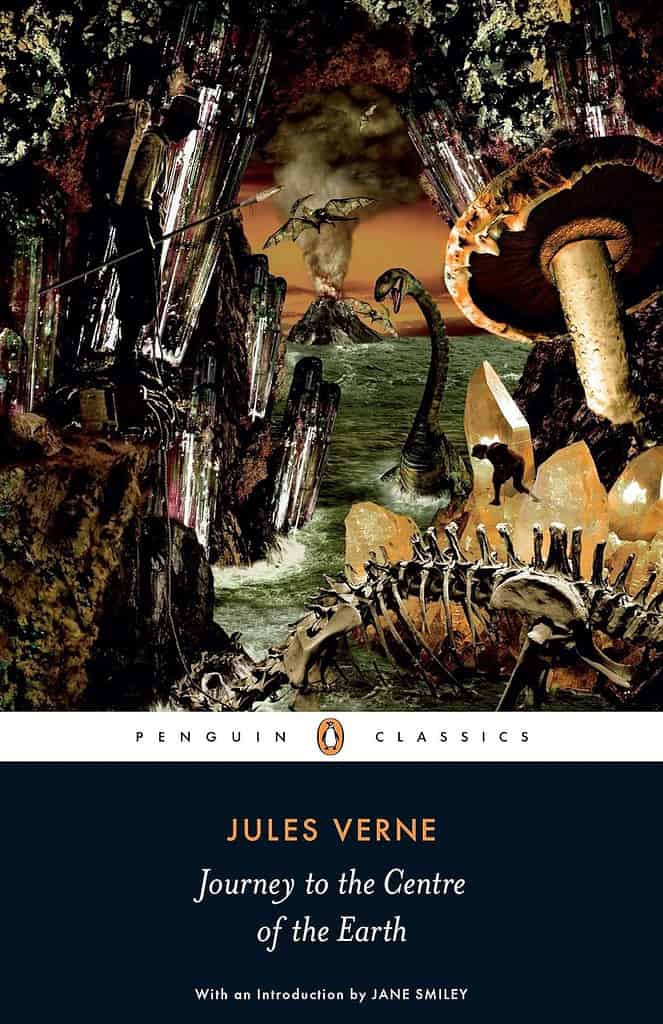
Journey to the Centre of the Earth by Jules Verne
“Journey to the Centre of the Earth” is a captivating tale of exploration and discovery. The story revolves around Professor Lidenbrock, his nephew Axel, and their guide Hans, who embark upon a daring expedition to the Earth’s core via a volcanic tube. Verne’s vivid imagination paints a picture of an incredible subterranean world filled with prehistoric animals and natural phenomena. Throughout their journey, the trio faces various obstacles, including dangerous creatures, treacherous terrains, and challenging weather conditions, all while dealing with the psychological stress of being thousands of miles beneath the Earth’s surface. This novel masterfully combines elements of adventure and science, underscoring Verne’s visionary approach to storytelling.
BUY FROM AMAZON OR BOOKSHOP

Twenty Thousand Leagues Under the Sea by Jules Verne
“Twenty Thousand Leagues Under the Sea” is Jules Verne’s thrilling underwater adventure that introduces us to the enigmatic Captain Nemo and his marvelous submarine, the Nautilus. When a mysterious sea monster is causing havoc in the ocean, marine biologist Professor Aronnax, his faithful servant Conseil, and the hardy harpooner Ned Land embark on an expedition to uncover the truth. They are captured by Captain Nemo and taken on an extraordinary journey beneath the waves, exploring the wonders and dangers of the ocean’s depths. Verne’s novel is not only an exciting voyage but also a commentary on the human desire for freedom and the destructive potential of advanced technology.
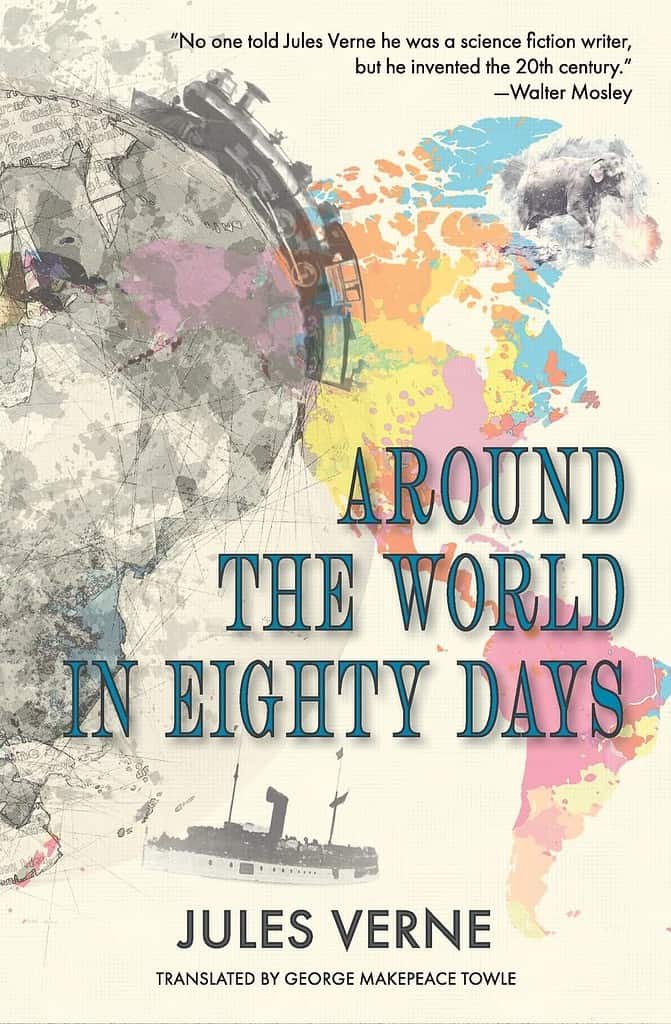

Around the World in Eighty Days by Jules Verne
“Around the World in Eighty Days” is a thrilling race against time as Phileas Fogg, accompanied by his loyal servant Passepartout, sets out to circumnavigate the globe in just eighty days. This novel captures the spirit of adventure and curiosity that characterizes most of Verne’s work, with a dash of comedy and romance thrown in. The story takes us through various countries and cultures, showcasing Verne’s incredible attention to detail and knowledge of geography. It is also a commentary on the advancements in transportation and technology during the 19th century. This timeless classic has been adapted into numerous films, plays, and TV shows, cementing its status as one of Jules Verne’s most beloved works.
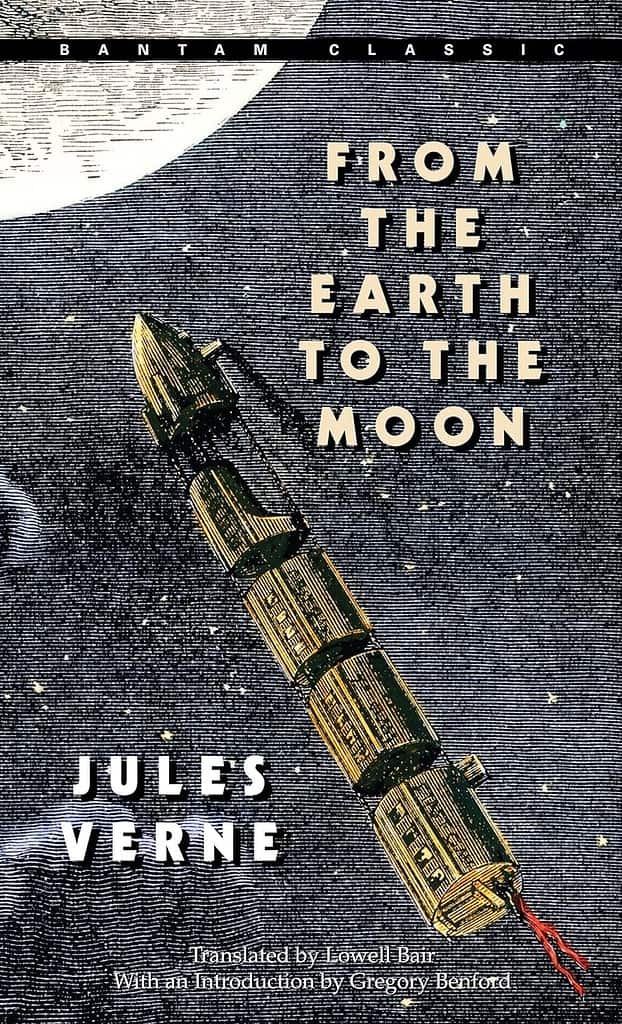
From the Earth to the Moon by Jules Verne
“From the Earth to the Moon” is a remarkable tale of man’s journey into space, written more than a century before humans actually walked on the moon. Verne’s detailed descriptions and scientific accuracy make this story almost prophetic in its ability to predict the future of space travel. The novel follows the members of a gun club as they plan and execute a mission to send a projectile to the moon using a giant cannon. Along the way, Verne explores themes of ambition, patriotism, and human ingenuity. This book is not only an incredible adventure but also an insightful commentary on mankind’s never-ending quest for exploration.

The Mysterious Island by Jules Verne
“The Mysterious Island” is a thrilling tale of survival and discovery as five men escape the American Civil War on a hot air balloon and end up stranded on an uncharted island in the Pacific Ocean. As they struggle to adapt to their new environment, they uncover mysteries and secrets that will test their skills, courage, and friendship. Verne’s attention to detail and scientific accuracy are on full display in this novel, as the characters use their knowledge of technology and science to survive and thrive on the island. This book is also a commentary on humanity’s relationship with nature and our ability to adapt to new challenges.

Frequently Asked Questions about Jules Verne
What was jules verne most famous for.
Jules Verne is most famous for his “Extraordinary Voyages” series, which includes iconic novels like “Twenty Thousand Leagues Under the Sea,” “Journey to the Center of the Earth,” and “Around the World in Eighty Days.” These works, known for their rich detail, imaginative scenarios, and visionary grasp of science and technology, have cemented Verne’s reputation as a stalwart of science fiction literature and a master storyteller.
Is Jules Verne considered a pioneer of science fiction?
Yes, Verne is widely considered to be one of the pioneers of science fiction. His imaginative and visionary works paved the way for the development of the genre as we know it today.
What Disney movie is based on Jules Verne?
The Disney movie “20,000 Leagues Under the Sea” is based on Jules Verne’s novel of the same name. This 1954 film adaptation remains one of the most popular interpretations of Verne’s work, bringing the thrilling undersea adventure of Captain Nemo to life on the big screen. Another Disney film, “Around the World in 80 Days” (2004) is also based on a novel by Jules Verne.
How accurate was Jules Verne’s From the Earth to the Moon?
Jules Verne’s “From the Earth to the Moon” is quite remarkable for its scientific accuracy, especially considering it was published in 1865, over a century before mankind actually set foot on the moon. Verne correctly predicted that the launch of the spacecraft would take place in Florida, USA, not far from where Cape Canaveral is located. He also foresaw the use of a sort of “cannon” or launch mechanism to propel the spacecraft, which is analogous to the usage of rockets in modern space travel.
However, there were discrepancies too. Verne’s spacecraft was a bullet-shaped capsule fired by a huge cannon, which would have been lethal for humans due to the extreme acceleration. Also, Verne imagined the capsule to be occupied by men who walked around inside it, whereas the actual Apollo mission involved astronauts floating in zero gravity. Verne’s story also envisaged a splashdown landing in the Pacific Ocean, which is what occurred with Apollo missions. Despite these differences, Verne’s vision of lunar exploration was extraordinarily prescient for its time.
What are the 4 inventions that Jules Verne predicted?
- Space Travel: In his novel “From the Earth to the Moon,” Jules Verne predicted that mankind would one day travel to space and even accurately described aspects of space travel such as weightlessness, zero gravity, and splashdown landings.
- Submarines: In “20,000 Leagues Under the Sea,” Verne imagined a futuristic underwater vessel named the Nautilus, which was powered by electricity and could travel underwater for extended periods. This concept was so ahead of its time that Verne’s description of a submarine closely resembles modern-day submarines.
- Helicopters: In his novel “Robur the Conqueror,” Jules Verne described a flying machine that resembled a helicopter with spinning rotors, which he named the “Albatross.” This prediction was made several decades before helicopters were actually invented.
- Video Conferencing: In his novel “The Carpathian Castle,” Verne described a device called the “telephoto” that allowed people to communicate and see each other in real-time, similar to modern-day video conferencing technology. This prediction was made over a century before the advent of Skype, FaceTime, Zoom and other video conferencing platforms. Overall, Jules Verne’s futuristic visions have continued to inspire generations of writers, scientists, and readers, and his works remain timeless classics that will continue to be enjoyed for many years to come.
What Age Should Read Jules Verne?
Jules Verne’s novels are filled with adventure, exploration, and wonder, making them appealing to readers of all ages. However, considering the complexity of the language, depth of the scientific concepts, and the historical context in which they were written, they might be more suitable for children aged 12 and above. For younger readers, there are also adapted versions of Verne’s classics that offer a more simplified language and narrative, perfect for introducing them to the world of Jules Verne. But ultimately, the right age to read Jules Verne can depend on the individual child’s reading level and interest in science and exploration.
Jules Verne was a literary genius who left a lasting legacy in the world of science fiction. His books inspired generations with their sense of adventure, scientific theories, and incredible imagination. From diving deep into the oceans to soaring high in the skies, the worlds within Jules Verne’s books will leave you captivated and dreaming of discovery. So whether you’re a long-time fan or a newcomer to the world of science fiction, Jules Verne’s books are a must-read for any lover of great adventure.
What do you think about these Jules Verne books?
Have you read any books by Jules Verne? Are any of these books or his other works on your TBR? What book by Jules Verne is your favorite? What other Jules Verne books would you add to this list? Let us talk about it in the comments below.
MORE BOOKS TO READ:
- 7 Must-Read C. S. Lewis Books: Where To Start Reading
+ show Comments
- hide comments, add a comment, leave a reply cancel reply, sign here by claudia lux », « from chaos to calm: strategies for overcoming daily overwhelm with jenna hermans, previous post, back to blog home.

Bookshelf Organization: 10 Ways To Organize Your Bookshelves

39 Screen-Free Activities To Do At Home

A Daily Ritual To Help You Get Out of Your Rut
So hot right now, free guide.

Spring is a time for new beginnings. Plus it’s the perfect time to refresh and renew your reading life. So if you're looking for the best new books of the season, this guide is just for you. The 2024 Spring Reading Guide has twenty-one new releases organized across six categories. You’ll also find some fun things to do at home, spring-themed recipes, plus more.
Download The 2024 Spring Reading Guide

A once-weekly e-newsletter to inspire your desire to read and live a life filled with books.
follow along on social:
© 2020 - 2023 THE BIBLIO GROUP, LLC | BIBLIOLIFESTYLE |
SEND ME A NOTE >
GET ON THE LIST >
@BIBLIOLIFESTYLE >
Links to third-party sites may include affiliate links. As a Bookshop, Amazon and Libro.fm Affiliate, BiblioLifestyle earns from qualifying purchases at no additional cost to you.

Suggestions

The Astonishing Science in Jules Verne’s Fiction Novels

Science fiction is often associated with fantastical concepts, such as the Force from “ Star Wars ” or the numerous alien worlds of “ Star Trek .” While these and many other examples of the genre present hypothetical inventions, few works offer these ideas as their central focus.
The science fiction novels of Jules Verne stand apart in this respect, as they use scientific research and calculations to showcase fictional machines that would become real creations many years later. Verne’s detailed descriptions of his ideas weren’t always accurate, but his work paved the way for many modern innovations.
Underwater Exploration in “Twenty Thousand Leagues Under the Sea”
Over 150 years after its release, “ Twenty Thousand Leagues Under the Sea ” from 1870 remains one of Verne’s most recognized and critically acclaimed works. The book chronicles the journey of Dr. Pierre Aronnax, a marine biologist who embarks on a hunting expedition with his servant, Conseil, and a harpooner named Ned Land. This expedition is cut short when they discover that the rumored sea monster they were searching for was actually a technologically advanced submarine called the Nautilus.
The three accompany its elusive Captain Nemo and his crew on their undersea travels. They learn about undocumented species of plants and sea creatures, explore underwater locations, and uncover the reason behind Nemo’s secretive nature and refusal to let the group return to land. The constant sense of mystery and wonder that Verne creates in “Twenty Thousand Leagues Under the Sea” is one that few other authors have successfully recreated.
Aside from the novel’s excellent storytelling and characters, “Twenty Thousand Leagues Under the Sea” is notable for its immense detail in describing an electronically powered submarine years before the concept was fully realized. Verne describes the Nautilus as cigar-shaped with a surface area of 1,011.45 square meters, a volume of 1,507.2 cubic meters, a length of 70 meters and a weight of 1,500 metric tons when completely submerged in water.
The novel also details how these measurements could impact the Nautilus’ movement in various circumstances. Even though the Nautilus seemed like an impossible idea when the book was written, Verne’s precise descriptions help the reader believe the fictional submarine could be a real machine.
The Nautilus is a culmination of Verne’s personal research into earlier submarine prototypes and calculations on how they could be improved. Verne studied some of the most notable designs, including the Nautilus’s namesake and the Plongeur . A model of the latter submarine at the International Exposition of 1867 served as one of the primary inspirations for “Twenty Thousand Leagues Under the Sea.” These inspirations allowed Verne to create a realistic vision of future submarine designs.
However, his limited knowledge of the subject and occasional use of creative liberties meant the fictional submarine’s design suffered from multiple scientific inaccuracies. An essay by Stuart K. Wier found the Nautilus to be surprisingly close to the designs of later submarines but argued its power source of sodium batteries (another prophetic invention by Verne) lacked the necessary power and longevity to support the submarine’s large size and maximum speed of 50 miles per hour. He proposes that the Nautilus could have only been powered by a nuclear reactor, another invention that had yet to be conceived while Verne was writing.
Despite its occasional inaccuracies, “Twenty Thousand Leagues Under the Sea” contained enough scientific elements to inspire the creation of Simon Lake’s Argonaut 1 , the first submarine to travel in the open sea successfully. Once news about this accomplishment spread around the world, Verne sent a telegram to Lake discussing the impact the invention would have on underwater exploration and warfare.
Verne may not have intended for his novel to drastically impact the future of science. Still, his unusual dedication to mechanical accuracy in literature helped him become a household name among casual readers and scientists alike.
Interstellar Travel in “From the Earth to the Moon”
Although Verne was able to consult earlier prototypes when designing the Nautilus, the concept of traveling into space had seen significantly less progress. Despite the lack of professional research available at the time, Verne’s 1865 “ From the Earth to the Moon ” delivered an early concept of a device that could send humans to the moon. The story presents the fictional Baltimore Gun Club and their efforts to construct a 900-foot cannon named the “Columbiad,” which would launch a projectile containing human passengers toward the moon.
Verne describes the Columbiad with a similar degree of detail as the Nautilus, including information on how he reached many of his mathematical conclusions within the novel. He explains the construction of the cannon and the measurements performed to determine its design. Unlike the Nautilus, his imagined cannon hardly resembles any modern technology and contains numerous impractical design elements.
In an article for Gizmodo, Ron Miller explains that Verne depicts a cannon rather than a rocket because of the differences in technical advancement between the two devices. Rockets were far less powerful than necessary to launch into space, whereas the cannon was already known as a powerful invention.
The choice may seem odd now, but readers at the time (and possibly Verne himself) were more likely to believe space travel could be accomplished with a cannon rather than the comparatively weak contemporary rockets.
Despite Verne’s attempts at scientific accuracy, the Columbiad suffers from numerous design flaws. The power and speed required to launch the projectile would subject its occupants to a fatal force of 30,000 Gs (or g-force, the force of gravity or acceleration on a body). The cannon would also compress and heat the air within its barrel, creating a dangerous obstacle for the projectile during its launch. It would be a guaranteed failure if Verne’s cannon were ever attempted in real life.
Even with these problems, “From the Earth to the Moon” successfully predicted and directly inspired the projects of future space programs. The Columbiad served as the basis for multiple military projects that attempted to create a “ space gun .” However, as Verne described, none of these projects successfully launched a projectile to the moon.
Additionally, Verne’s novel portrays a conflict between Florida and Texas as they attempt to convince the Gun Club to construct the cannon on their land. After an extensive debate, the club determined Tampa, Florida (named “Tampa Town” in the novel), to be the ideal location for the cannon due to its distance from other towns and closeness to the equator; the latter created a direct path to the moon.
These events would be repeated nearly a century later , in 1962, when NASA rejected a location near Brownsville, Texas, in favor of Merritt Island, Florida, for the construction of the Kennedy Space Center . An interview with Robert Launius, a historian and curator at the Smithsonian National Air and Space Museum, revealed that this choice was also inspired by its closeness to the equator and distance from civilian areas.
The book “From the Earth to the Moon” is far from being a scientifically accurate novel, but it embodies everything that made Verne’s works so notable. His combination of extensive research and entertaining, grounded fiction introduced the study of space travel to many readers and encouraged future scientists to question how to bring the novel’s ideas to life. Most importantly, the book provides contemporary readers with an understanding of how the field of astronautics was perceived in the middle of the 19th century.
Everyday Devices of “Paris in the Twentieth Century”
Verne’s most popular novels often adopt a pro-science perspective toward new inventions. The Nautilus, Columbiad and other inventions by Verne are depicted as beneficial to the advancement of science. However, his later works contrast with this approach by adopting a more cynical tone, with many of these novels delivering cautionary tales against the possible dangers of technology.
One of the most notable examples is an unpublished 1863 manuscript titled “ Paris in the Twentieth Century .” The story attempts to imagine the city of Paris and its people from 100 years into the future. This concept is explored through the lens of Michel Dufrénoy, a teenage literature major who grows increasingly resentful of the technology-focused world as the novel progresses. Verne’s view of the 20th century is primarily dominated by tech companies, whereas aspiring artists and writers are typically destitute.
Verne’s publisher, Pierre-Jules Hetzel , rejected the draft and harshly criticized the story as being overly pessimistic and unrealistic. However, the novel has since been reevaluated as a surprisingly accurate vision of the future after it was rediscovered by Verne’s great-grandson, Jean Verne , and finally published in 1994.
Along with a surprisingly accurate description of the future prioritization of technology, “Paris in the Twentieth Century” described multiple inventions that arose during or near the 1960s.
Verne envisioned drastic innovations in transportation in the form of increased roads for automobiles and the creation of a subway network. He also predicted computers and the internet when describing “calculating machines” that operated through keyboards and served as “electric telegraphy” for global communication.
One final prediction, and perhaps the most optimistic part of the novel, was the concept of weapons of mass destruction that would deter countries from engaging in war. These are not the only examples of Verne’s foresight, but they highlight his understanding of how technology would restructure modern life.
Verne was not an expert in any scientific or engineering fields. He lacked formal training in many of the subjects described in his novels and primarily wrote adventure novels set in different parts of the world rather than science fiction.
Despite his lack of expertise, his dedication to creating believable yet imaginative stories used the science-fiction genre to its fullest potential. As a result, his works can be enjoyed as entertaining adventure novels and as historical treatises on what the future of science would look like from a 19th-century perspective.
- Jules Verne
- science fiction
- science fiction novel
Maximilian Padilla-Rodriguez, Florida Atlantic University

Writer Profile
Maximilian padilla-rodriguez, florida atlantic university english.
Maximilian Padilla-Rodriguez is an English major currently working toward completing his senior year at Florida Atlantic University. When not busy with course work, he spends his free time reading both fiction and nonfiction.
Leave a Reply
Your email address will not be published.
Save my name, email, and website in this browser for the next time I comment.
Related Posts

The Islamic Blueprint of Dune

Read Between the Lines: The Problem With the Goodreads Challenge

The Pressure Surrounding Female Writers and Romance

‘Star Trek’: Jake Sisko’s Coming of Age Story

‘Stargate’ May Be Sci-Fi’s Most Self-Aware Franchise

2023 Winter Book Releases You Need To Read

Sleeping Through Days: Moshfegh’s Idea

The Use of Multiple POV in ‘Frankenstein’
Don't miss.

What’s the Obsession with ‘Bluey’?

The Brilliance of Amy Sherman-Palladino’s Leading Ladies in Television

Latine Streetwear Fashion: An Evergreen Vogue and Indigenous Resistance to Whiteness

Easy-A UVA Classes

Dark Cafes and Big Yellow Taxis—The Everlasting World of Joni Mitchell

Can Jules Verne’s vision of giant space guns ever become a reality?
Forget rockets, gigantic guns might be the way to go to get stuff into space..
Christopher McFadden

The "Naked Cannon" on the Penya Roja
Blickwinkelfoto/iStock
Since the very early days of science fiction, many authors and thinkers have dreamed up some interesting, dare we say, almost insane methods that humans might one day explore the cosmos. Some of these have become a reality, like rockets, but by far one of the most outlandish is something called a “ space gun “.
Effectively enormous, powerful, and cannon-like devices, these enormous pieces of engineering have been considered for decades. But, what exactly are they, and how would they work?
Let’s take a look.
What are space guns?
As you can probably work out from the name, space guns are a proposed method of launching things into outer space using a large projectile launcher. Most designs are enormous guns or cannons, and were perhaps first proposed by none other than Jules Verne in his sci-fi classic “ From the Earth to the Moon “.

In Verne’s vision of future space travel, an American post-Civil War Society, called the Baltimore Gun Club, embark on an outrageous attempt to go to the Moon. Club members attempt to assemble a gigantic Columbiad (a type of smoothbore cannon) to act as an enormous firearm big enough to launch human beings into space.
Interestingly, and considering the lack of genuine scientific study into such an endeavor, Verne even made some attempts at making some basic calculations on the requirements of such a gun. Despite his lack of empirical data, his estimations have proven to be remarkably accurate.
Unlike the scenario in Jules Verne’s fiction, it is highly unlikely that such a technology, if devised, could ever realistically be used to launch human beings into space. For non-living, robust objects, on the other hand, this technology might have some utility.
With regards to being used as a means of transporting humans into space, the G-forces involved to enable a human-carrying projectile to reach escape velocity would be too much for the human body to endure. For other objects, like freight or particularly robust/rugged satellites, etc, space guns could be an interesting and cheaper alternative to rockets.
However, the incredible forces involved in this kind of delivery system can limit the kinds of things that could realistically be fired into space. That being said, the G-forces involved in space gun launches, according to some, are “often over-exaggerated”.
“Military artillery shells today have GPS, laser-guidance optics, and electronics that survive these accelerations, so it can be done. Obviously, not everything can be launched this way, but the gun launch is well suited for launching fuel and building materials,” explained Andrew Higgins , a professor at the Department of Mechanical Engineering at McGill University, Canada to the BBC .
The concepts for this type of device vary considerably, from using combustion (as in a conventional firearm), high-pressure gases, even railgun-like versions. Pneumatic launch systems, for example, accelerate the payload “bullet” along a very long barrel using air pressure produced by a ground-based turbine (or other means).
For ballistic-type space guns, the concept is well established and even somewhat proven. However, the main problem for reaching space with this technology is finding ways to maintain the very high velocities needed to reach escape velocity. The main enemy here for the technology is air resistance and aerothermal heating that can, and will, significantly degrade any projectile’s velocity over time.
“Punching through the lower (denser) part of the atmosphere at high speed is an intense heat transfer problem, but ablative coatings and heat shields on the nose of the projectile should be up to the job,” added Higgins.
While many of the earlier attempts to make a space gun a reality are all now effectively defunct, the reality of space guns appears to be over. However, according to experts like Higgins, it could see a resurgence in the future.
“Rather than throwing away the first stage of a rocket, using a large gun for the first stage would enable this hardware to be reused and easily serviced,” he said.
Let’s take a look at some notable real-world attempts at making a working space gun.
1. The Germans built something similar in WW2 – except for war, not space exploration

During the Second World War, Germany made a series of experimental weapons platforms in an attempt to turn the tide of battle in their favor. Called the “Vengeance Weapons”, the program consisted of the well-known V1 flying bomb, and the world’s first long-range ballistic missile, the V2 rocket.
But, there was a third weapon called the V-3 . It was a lso known as the Hochdruckpumpe (“High-Pressure Pump,” or HDP for short) — a code name intended to hide the real purpose of the project. It was also known as Fleißiges Lieschen (“ Busy Lizzie “).
This weapon was to be used to fire projectiles over incredibly long ranges from strategic underground locations across Europe.
The first test facility was built in the Pas-de-Calais area of France, in a top-secret subterranean facility hidden from view at the surface. Within the facility, a series of extremely long “barrels” were built in specially angled chambers which were trained in London, UK .
Each was able to launch a 310lb (140kg), 5.9-inch, (15cm) diameter shell over a distance of well over 55 miles (88km). The shells were fired by multi-charge ignition propulsion, where a series of secondary propellant charges were placed along the barrel to accelerate the projectile to incredibly high velocities.
As the projectile passed each secondary charge, it would be triggered, discharging more hot gas behind the projectile, pushing it further forward, and accelerating the projectile as it went. Solid-fuel rocket boosters were used for this purpose. Compared to explosive charges, they were much safer to handle and easier to install and replace.
The charges were arranged in symmetrical pairs along the length of the barrel, angled towards the “muzzle” to maximize their impact on the base of the projectile as it passed.
Interestingly, the barrel and side chambers were designed as identical sections to simplify production and allow damaged sections to be replaced. It also meant they could be constructed and potentially moved in sections with relative ease.
The inner surface of the barrel was smooth, and the projectiles used consisted of fin-stabilized shells that depended upon aerodynamic forces rather than gyroscopic forces to prevent tumbling (distinct from conventional rifled weapons which cause the projectile to spin). This setup resulted in a lower drag coefficient, and a more stable flight once launched.
The V-3, if ever completed and successful, would have been able to easily bombard London from the relative safety of German-occupied France at a rate of one shell every six seconds. There would have been no reliable defense or countermeasure against such an attack beyond destroying the weapon.
The whereabouts of the weapon were discovered and a bombing raid was arranged to knock out the facility before it could be completed. The site still exists to this day and is now a museum where visitors can inspect what remains of the facility and guns.
Similar but smaller versions of the weapon were, however, used to bombard Luxembourg from December 1944 to February 1945.
The weapon, with a good deal of modification and development, could have conceivably also been adapted for use as a kind of space gun.
2. The U.S. once developed an anti-ballistic missile space gun

Back in the 1980s, the United States once attempted to develop a ground-based gun that could target and knock out ballistic missiles in low-Earth orbit. Developed as part of the Super High Altitude Research Project (SHARP), it was never completed.
While it was in development, the gun was the largest gas gun in the world at the time.
The system comprised of a light-gas gun that was, if ever fully developed, intended to destroy targets traveling in excess of Mach 9 or 6,905 mph (11,113 kph). The space gun was developed at the Lawrence Livermore Laboratory and used compressed gas to accelerate projectiles to extremely high velocities.
Similar technology is used in various physics experimental apparatus to research the effects of high-velocity impacts from things like meteorites, etc. It works in a similar fashion to spring-piston airguns by using a larger piston to force gas through a barrel.
SHARP, however, rather than consisting of a single long barrel, consisted of an L-shaped design with two separate sections. A methane gas mixture is ignited behind the piston and the resultant explosion rapidly drives the piston down the barrel and compresses a pre-pressurized gas in the barrel. A small projectile is inserted into the launch tube and is then driven down the barrel at extremely high velocities. The gun’s enormous recoil was then absorbed by specially designed rail-mounted sleds.
SHARP, when tested, was able to launch its 11-lb (5kg) projectiles at speeds of around 6,700 mph (3 km/s) to 450 km in altitude. Further tests were planned to elevate the barrel towards space and improve the design to enable it to fire projectiles in excess of Mach 21, however, the project was later canceled in the early-1990s.
3. SHARP could have led to an even larger “Jules Verne Launcher”
As impressive as SHARP was during its day, it would have been only the first step to an even larger, and much more impressive space gun called the “ Jules Verne Launcher “. This would have been an even larger version of SHARP with an 11,500 foot long (3,500m) barrel.
According to a study at the time, by the team behind SHARP, the “ Jules Verne Launcher ” would have been able to deliver “3.3 metric tons to a 500 km low earth orbit.”
Impressive enough, but the scientists who proposed the project continued to make some bold predictions about the gun, writing, “our results indicated that the JVL will be able to deliver 1000 metric tons of payload to LEO yearly. The cost will be 5% of the best US rocket delivery cost. This technology will enable the next phase of [our] exploration of space.”
Designed in the early-1990s, the space gun would have been used to launch satellites into orbit without the need for a rocket. With a potential cost of around $1 billion, the project failed to drum up enough support to ever get the funding.
For this reason, among others, it never really left the drawing board.
4. “Quicklaunch” is an underwater variation on the theme of space guns

In the aftermath of the cancellation of SHARP , one of its critical team members, John Hunter, decided to continue to develop the idea in the private sector. To this end, he founded the Jules Verne Launcher Company (now defunct) in the mid-1990s, and then later the Quicklaunch Company (also now defunct).
These private ventures continued to work on the concept while also bidding for private investment, with the company able to raise around $500 million in 2012. The idea for the “Quicklauncher” space gun was to complete a large light-gas gun capable of delivering to a space-based depot fuel or other bulk materials capable of surviving the extreme forces produced by this kind of space delivery system.
What’s more, other proposals for the system suggested it could have been deployed in a large body of water, roughly 600 feet (183m) down. The gun would have been around 1,300 feet long (400m) and capable of shooting payloads of around 100-lbs (45kg) into low-Earth orbit.
To make the most of the slingshot effect, the space gun would be best situated as close to the equator as possible and should be able to fire off up to ten launch vehicles a day.
According to Hunter, the project never really got going because of “internal issues”. In 2016, he told the BBC “It’s no more. There’s some intellectual property there but the members have split up.”
However, Hunter believed his approach went a long way to adequately reducing the cost of taking payloads to space. He has reportedly encouraged anyone with enough money and motivation to take up the mantle and reinvestigate the technology, although h e added that the progress made by Space X makes it unlikely that any supergun projects would restart.
“For now, with the work, Elon Musk is doing with Space X there’s no room for a project like Quicklaunch,” Hunter told the BBC . “But I’m happy as a clam for Elon, I really am, because it takes the monkey off my back.”
5. Saddam Husein even had a go at making one, albeit for different reasons

Of all the attempts to realize Jules Verne’s vision, perhaps the closest was “ Project Babylon, ” developed in the late-1980s. Developed by the artillery engineer Gerald Bull, the gun was developed for use by the Iraqi Government under Saddam Hussein.
Gerald Bull was a Canadian engineer and inventor who had high ambitions, pun intended, to develop specialist large guns which could fire things like satellites into orbit from bases on terra firma.
In the early-1980s, Bull was contacted by Iraqi officials to help them develop special artillery for the Iran-Iraq war. At this time, Saddam Husein was Iraq’s defense secretary and he had some ambitions to develop an Iraqi space program.
Bull was apparently intrigued by the possibility, notably the space program part, and agreed. To this end, he was given a $25 million budget to develop what would become Project Babylon.
Throughout the late-1980s, three superguns were developed, including two full-sized “Big Babylon” 39.37-inch (1000mm) caliber guns and a prototype 13.87-inch (350mm) caliber gun called “Baby Babylon”. The former, if completed, would have been 512 feet (156 meters) long. It would also have weighed 1,510 tonnes – far too big to be transportable. To this end, it would have been mounted at a 45-degree angle on a hillside.
Using a special propellant, it has been estimated that the gun could have fired a 1322.77-lb (600kg) projectile at a range of 621 miles (1,000 km), give or take. Alternatively, the gun could be used to launch a 4409.245-lb (2,000kg) rocket-assisted projectile carrying a 441-lb (200kg) satellite.
Bull was actually assassinated before the project could ever be completed. To this day, little is known which country, or person, actually committed the act, but it has been strongly suggested that Israel’s Mossad is the most likely candidate. Israel has officially denied any connection to the event, and the United States, United Kingdom, South Africa, and senior figures in Iraq itself also had reasons to have ordered the hit.
After Bull’s death, the project effectively stalled and parts destined for the supergun are on permanent display at the Royal Armories collection at Fort Nelson in Hampshire, England, UK.
For now, the concept of space guns is pretty much dead in the water. The leaps and bounds being made by private rocket companies like SpaceX are effectively crowding out the potential benefits of space guns for the moment.
But, never say never. There is the remote possibility that private ventures somehow “drop the ball”, leaving some room for space guns to make a return.
However, the technology that underpins most space gun designs is still very much in existence today – albeit on a much smaller scale. Various universities use them on a regular basis for testing high-velocity impacts on things like satellite “armor”.
These devices effectively analyze the effects of high-velocity space debris to find ways to better protect satellites in orbit. Space guns, or rather high-powered gas guns, are the only realistic way of simulating these events on Earth.
Will we see space guns see a revival in the future? Much like Norman Peale’s famous quote “shoot for the moon. Even if you miss, you’ll land among the stars,” it might just be worth a shot.
RECOMMENDED ARTICLES
The blueprint daily.
Stay up-to-date on engineering, tech, space, and science news with The Blueprint.
By clicking sign up, you confirm that you accept this site's Terms of Use and Privacy Policy
ABOUT THE EDITOR
Christopher McFadden Christopher graduated from Cardiff University in 2004 with a Masters Degree in Geology. Since then, he has worked exclusively within the Built Environment, Occupational Health and Safety and Environmental Consultancy industries. He is a qualified and accredited Energy Consultant, Green Deal Assessor and Practitioner member of IEMA. Chris’s main interests range from Science and Engineering, Military and Ancient History to Politics and Philosophy.
FEATURED VIDEO
Popular articles, new mussel-inspired one-shot nanoparticle assembly technique to aid energy applications, new active hydrothermal vents spotted 8366 feet beneath ocean surface, caltech scientists turn jellyfish into augmented deep-sea explorers, boeing’s bad patch explained: how the aero behemoth fell from grace, related articles.

Magnetic microrobot swarms clean water of microplastics and bacteria

Chang’e-6: China likely planning to deploy secret rover to Moon’s far side

Scientists discover 1st elusive ‘glueball,’ particle made of nuclear force

Point of no return: NASA supercomputer simulates falling into a black hole

FEATURED STORIES

10 Best Movies Based On Jules Verne Books, Ranked
- Jules Verne's work has inspired numerous movie adaptations and is the foundation for some of the earliest science fiction films.
- Some Jules Verne adaptations are entertaining and enjoyable, while others are outdated and not required viewing.
- The film "Journey to the Center of the Earth" (2008) successfully updates Verne's classic story with modern special effects and remains fun to watch.
Jules Verne is undoubtedly one of the most prominent authors in science fiction , and its no wonder that his works have inspired countless movie adaptations. One of the most translated writers in human history, the French author has written legendary tales like 20,000 Leagues Under The Sea, Journey to the Center of the Earth, and Around the World in 80 Days . Verne's daring imagination put him far ahead of his time, and it's no surprise that movie studios have sought to replicate his sense of wonder with multiple live-action adaptations of Jules Verne stories .
Jules Verne's work has become the foundation for some of the earliest films in the science fiction genre , some of which even hold up today remarkably well as enjoyable, adventurous romps through the imagination. The mid-to-late 2000s saw a resurgence of Jules Verne films as well, to varying degrees of success, with studios hoping to recapture the joy and nostalgia of the earliest films to adapt Verne's books for a new generation. With so many familiar titles, it's a difficult task to distinguish the very best depictions of Jules Verne's novels over the years.
Journey To The Center Of The Earth
An easily-overlooked made-for-TV movie, the two-part Journey to the Center of the Earth special was a solid attempt at getting to the center of what made Verne's original story so memorable. The film is decidedly slow-moving and low-budgeted, with some creature effects occasionally bordering the precipice of acceptable for a shoestring budget, but the C-List actors can often bring in decent performances amid the campy set-dressing. Despite it's many flaws, the two-part film is an entertaining, knowingly campy jog through Verne's beloved tale of subterranean exploration.
Master Of The World
Master of the World is the sole film to adapt Jules Verne's novel of the same name, and when compared to his other, more well-known stories, it's easy to see why. The narrative of a rich maniac dedicated to the idea of threatening the world's governments into laying down their arms isn't quite as whimsical as Verne's other premises. As for the film, despite rich talent from the likes of a young Charles Bronson and the legendary Vincent Price , the special effects are especially outdated, even for the time period . Master of the World is fun, but not required viewing.
Journey 2: The Mysterious Island
Journey 2: the mysterious island.
Journey 2: The Mysterious Island is the follow-up to 2008's Journey to the Center of the Earth. The film takes place four years after the original, showing Sean Anderson (Josh Hutcherson teaming up with Hank, his stepfather, to find his lost grandfather. Due to scheduling issues, Brendan Fraser wasn't able to return as Trevor Anderson but was replaced by Dwayne Johnson as the film's lead.
Release Date 2012-02-12
Director Brad Peyton
Cast Josh Hutcherson, Michael Caine, Vanessa Hudgens, Dwayne Johnson
This semi-adaptation picks up where 2008's Journey to the Center of the Earth left off, replacing Brendan Fraser with Dwayne "The Rock" Johnson. As the passable action adventure delves into the incredible isle, the tone rides a strange line, at once too scary for younger viewers and too subdued for older ones. Amid mediocre CGI and all-too subdued performances, the best thing that can be said about Journey 2: The Mysterious Island was how it pioneered the art of throwing Johnson into a jungle, later done better in films like Jungle Cruise and Jumanji: Welcome to the Jungle .
Around The World In 80 Days
Though the idea of circumnavigating the globe in the span of 80 days is now a triviality, in Verne's time, such a time was the stuff of science fiction. The 1956 take on the story is an incredibly grand adventure comedy with a runtime that feels nearly as long as the titular journey itself. The international cast is crammed with stars of Hollywood's Golden Age , who had enough charisma between them to earn the film an early Academy Award for Best Picture. Today, the spectacle and aged humor can be best appreciated as a museum of 50s stardom.
Starring a young Josh Hutcherson and Brendan Fraser, still hot off the success of The Mummy trilogy , 2008's Journey To The Center Of The Earth had all the makings of an action-adventure hit. Being the first to truly update one of Verne's classic stories with modern special effects, the film still looks great 15 years later, even if it is marred by several obvious moments clearly meant to be enjoyed in the context of a 3-D theater. Adapting the classic adventure about as well as it could have, Journey To The Center Of The Earth isn't revolutionary, but undeniably fun.
While most adaptations of Verne's work make at least some departures from the source material, 2004's Around The World In 80 Days completely re-imagines the story as a raucous action-comedy. Though critically-panned at the time, the film is endlessly re-watchable today , with eye-popping action choreography courtesy of Jackie Chan's Passepartout and deadpan comedic timing from Steve Coogan's Phineas Fogg. If the anachronisms and deviations from Verne's novel can be forgiven, Around The World In 80 Days is a creative globe-trotting adventure that doesn't get the respect it deserves.
There's simply no replicating the cheesy fun of the original Journey To The Center Of The Earth , an earnest science fiction adventure movie that wears its heart on its sleeve. The special effects are certainly dated, but it's hard not to wring a certain level of charm out of the delicately hand-painted backgrounds and practical lizardman costumes. Beyond the addition of the deliciously dastardly villain, Count Saknussemm, the film is also one of the most faithful to Verne's work, a commendable effort in and of itself.
The Mysterious Island
The Mysterious Island is one of Jules Verne's lesser-known stories, but the 1961 film of the same name takes every advantage of the novel's conceits. Following a group of Union soldiers in the Civil War who escape prison in a hot air balloon only to wash up on a bizarre uncharted island, the film's sense of tension only ever dials up, as the heroes contend with grimy human pirates and giant fauna rendered by the talent of stop-motion legend Ray Harryhausen . Not the deepest narrative, this thrilling tale of danger holds up decades later remarkably well as a harrowing odyssey.
20,000 Leagues Under The Sea
One of Disney's earliest forays into live-action storytelling, 20,000 Leagues Under the Sea presented the aquatic crew of the Nautilus with untold dangers then-undreamed of by 50s audiences. Beyond the great creature and sci-fi technology designs that still hold up today, the film offers substantially more heart than most other Verne adaptations, taking the time to acclimate the viewer with its intrepid adventurers. It's no wonder that 20,000 Leagues Under the Sea was influential enough to earn a spot as a Disneyland mainstay even seven decades after its original release.
A Trip To The Moon
It's only fitting that the world's first science fiction movie sprung from the mind of one of the genre's most influential authors. Presenting early audiences with a dizzying idea of space travel long before the first astronaut was born, A Trip To The Moon 's hypnotic, almost feverish visuals and brisk 14-minute run time assaults the imagination with a yet-unmatched spectacle of dreamlike reality. From the Moon's incredulous face to the dancing insectoid aliens that vanish in a literal puff of smoke, A Trip To The Moon is by far the most influential science fiction film courtesy of Jules Verne.

Are Solar Sails the Future of Space Travel?
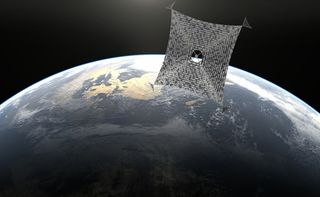
A new method of space travel is about to get its moment in the sun.
Several upcoming missions aim to harness the subtle push of sunlight, using gossamer " solar sails " to cruise through the heavens like boats through the sea. Such propellant-free propulsion could take craft cheaply and efficiently to a variety of destinations, from locations in near-Earth space to the edge of the solar system and beyond, advocates say.
A spacecraft equipped with a sail 1,300 feet (400 meters) wide, for example, could travel 1.3 billion miles (2.1 billion kilometers) per year, allowing it to escape the sun's sphere of influence in just a decade or so, according to researchers behind the Interstellar Probe, a NASA concept mission proposed about 15 years ago. [ Photos: Solar Sail Evolution for Space Travel ]
"There's nothing known to us now that could actually attain that kind of a speed using chemical propulsion," aerospace engineer Bruce Campbell said last week during a presentation with NASA's Future In-Space Operations (FISO) working group.
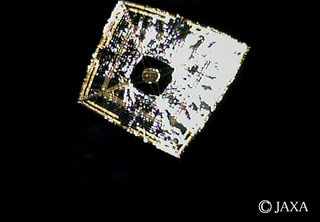
Paving the way
Solar radiation pressure provides a very small push to a spacecraft. But this push is continuous and can thus accelerate a probe to tremendous speeds over time.
Harnessing sunlight in this way is not a new idea. Jules Verne mentioned the possibility in his 1865 book "From the Earth to the Moon," and Arthur C. Clarke wrote about a solar-sailing spaceship race a century later, in the 1964 short story "Sunjammer."
Get the Space.com Newsletter
Breaking space news, the latest updates on rocket launches, skywatching events and more!
But it took a long time for solar sails to go from concept to reality. The first successful demonstration of the propulsion system didn't come until 2010, when Japan's Ikaros probe deployed its 46-foot-wide (14 m) sail and became the first craft ever to cruise through space on the backs of photons.
NASA followed suit five months later, launching the tiny NanoSail-D demonstrator to Earth orbit in November 2010. NanoSail-D unfurled its sail in January 2011, then circled the planet for eight months before burning up in the atmosphere.
Other projects now loom on the horizon, building momentum for the technology. A big milestone should come in early 2016, when NASA plans to launch the largest-ever solar sail to space.
The $27 million Sunjammer mission , which takes its name from the Arthur C. Clarke story, will use a sail built by California-based company L'Garde that measures 124 feet (38 m) on a side. The sail, made of an advanced material called Kapton, is just 5 microns (about 0.0002 inches) thick. It weighs less than 70 pounds (32 kilograms) and packs down to the size of a dishwasher, NASA officials have said.
The current plan calls for outfitting Sunjammer with some sun-monitoring instruments and sending it out to a spot about 1.8 million miles (3 million km) from Earth, along the Earth-sun line. That's twice as far away as the Earth-sun Lagrange Point 1 (L1), a gravitationally stable spot in space that has hosted various heliophysics and space-weather missions over the years. [ Photos: Meet Sunjammer, World's Largest Solar Sail ]
"What we intend to do with Sunjammer is demonstrate that a solar sail is an opportune device to place solar-warning instruments closer toward the sun than is currently allowed with just conventional systems at L1," L'Garde president Nathan Barnes said during a FISO talk in February.
Spacecraft positioned at L1 help researchers and the world prepare for space weather events, detecting huge clouds of super-hot solar plasma known as coronal mass ejections (CMEs) about 40 minutes before they may hit Earth (where they can disrupt power grids, GPS signals and radio communications).
So a probe twice as far away would provide warnings twice as early, Barnes said.
"This advancement would bring a number of folks a large level of security and comfort," he said.
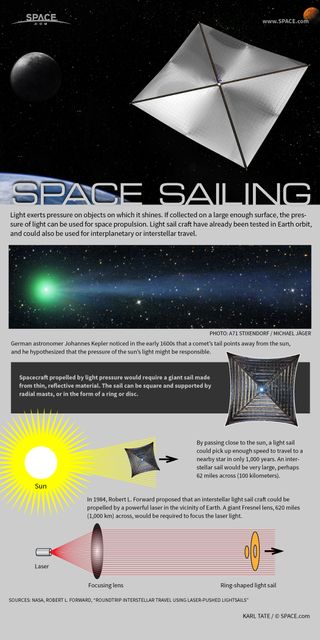
To the moon?
Sunjammer isn't the only solar-sail mission in the works. The nonprofit Planetary Society, for example, is working on a project called LightSail-1, which will launch a roughly 10-pound (4.5 kg) spacecraft to Earth orbit.
The goal is to demonstrate navigational control and use sunlight pressure to increase the craft's speed, further proving out solar-sail technology, Planetary Society representatives said.
NASA researchers are also developing a mission concept called Lunar Flashlight, which would send a tiny, sail-equipped "CubeSat" to the moon . The sail would not just provide propulsion; it would act as a mirror for Lunar Flashlight as well, reflecting sunlight down into shaded lunar craters so that onboard sensors could search these features for water and other volatile compounds.
"This innovative, low-cost concept will map the lunar south pole for volatiles and demonstrate several technological firsts, including being the first CubeSat to reach the moon, the first mission to use an 80 square meters [860 square feet] solar sail and the first mission to use a solar sail as a reflector for science observations," NASA officials write in an online description of Lunar Flashlight.
Sails could also help alleviate the world's growing space-junk problem, by allowing defunct or dead satellites to de-orbit safely. The European Space Agency, in fact, hopes to conduct an in-space test of a de-orbit sail called "Gossamer" by the end of 2014.
And some researchers have even higher hopes for solar sails, suggesting that a truly enormous sail —one the size of Texas, for example — could send a spaceship to another star system in just a few centuries. (A space-based laser would have to shine a powerful beam on the sail as the craft moved farther and farther away from the sun, however.)
While meteoroids will pierce solar sails from time to time, such impacts should degrade the sails' performance only very slowly, Barnes said. So the technology may end up changing the way engineers plan and design space missions.
"If solar sails get up and off the floor and start running, it will really come down to a new paradigm shift in spacecraft design," Barnes said. "Instead of designing a spacecraft around 50 [kilograms] of hydrazine [110 pounds] that you have in your tank, you will now have to design that spacecraft and all of the components and all of the systems around a lifetime of propulsion."
Follow Mike Wall on Twitter @michaeldwall and Google+ . Follow us @Spacedotcom , Facebook or Google+ . Originally published on Space.com .
Join our Space Forums to keep talking space on the latest missions, night sky and more! And if you have a news tip, correction or comment, let us know at: [email protected].

Michael Wall is a Senior Space Writer with Space.com and joined the team in 2010. He primarily covers exoplanets, spaceflight and military space, but has been known to dabble in the space art beat. His book about the search for alien life, "Out There," was published on Nov. 13, 2018. Before becoming a science writer, Michael worked as a herpetologist and wildlife biologist. He has a Ph.D. in evolutionary biology from the University of Sydney, Australia, a bachelor's degree from the University of Arizona, and a graduate certificate in science writing from the University of California, Santa Cruz. To find out what his latest project is, you can follow Michael on Twitter.
Lego Marvel The Amazing Spider-Man review
Lego Star Wars Millennium Falcon (2024) review
Boeing Starliner 1st astronaut flight: Live updates
Most Popular
- 2 Boeing Starliner's historic 1st astronaut launch delayed by Atlas V rocket issue
- 3 'Sparkly' narwhal toy trades sea for space as Boeing Starliner zero-g indicator
- 4 Watch 2 bus-size asteroids make close flybys of Earth this week (video)
- 5 Spacecraft captures absolutely incredible video of plasma swirling on the sun

COMMENTS
From the Earth to the Moon: A Direct Route in 97 Hours, 20 Minutes (French: De la Terre à la Lune, trajet direct en 97 heures 20 minutes) is an 1865 novel by Jules Verne.It tells the story of the Baltimore Gun Club, a post-American Civil War society of weapons enthusiasts, and their attempts to build an enormous Columbiad space gun and launch three people — the Gun Club's president, his ...
From the Earth to the Moon, novel by Jules Verne, published as De la Terre à la Lune (1865) and also published as The Baltimore Gun Club and The American Gun Club. Although the novel was subtitled Trajet direct en 97 heures 20 minutes ("Direct Passage in Ninety-seven Hours and Twenty Minutes"), the actual journey to the Moon was depicted in the book's sequel, Autour de la Lune (1870 ...
From £ 1045 pp. Details. More Tours. Jules Verne offer innovative small group escorted tours with a twist for people who love travel. With authentic touches and little extras, you'll experience the true character of each destination..
Novels of French writer Jules Gabriel Verne, considered the founder of modern science fiction, include Journey to the Center of the Earth (1864) and Around the World in Eighty Days (1873). This author who pioneered the genre. People best know him for Twenty Thousand Leagues Under the Sea (1870). Verne wrote about space, air, and underwater travel before people invented navigable aircraft and ...
Jules Verne (born February 8, 1828, Nantes, France—died March 24, 1905, Amiens) was a prolific French author whose writings laid much of the foundation of modern science fiction. Verne's father, intending that Jules follow in his footsteps as an attorney, sent him to Paris to study law. But the young Verne fell in love with literature ...
Along the Frontier of Imagination and Science. In the mid-19th century, Jules Verne intrigued the world with his sci-fi novel From a Cannon to the Moon, wher...
Highly influential in popularizing the science of science fiction was the 19th-century French writer Jules Verne, whose means of space travel in his 1865 novel, From the Earth to the Moon (and its sequel, Around the Moon), was explained mathematically, and whose vehicle — a gun-launched space capsule — has been described as the first such ...
Jules Gabriel Verne (/ v ɜːr n /; French: [ʒyl ɡabʁijɛl vɛʁn]; 8 February 1828 - 24 March 1905) was a French novelist, poet, and playwright. His collaboration with the publisher Pierre-Jules Hetzel led to the creation of the Voyages extraordinaires, a series of bestselling adventure novels including Journey to the Center of the Earth (1864), Twenty Thousand Leagues Under the Seas ...
Jules Verne envisioned building a projectile for space travel in "From the Earth to the Moon." (E.A. Bayard via Scribner, Armstrong / Smithsonian) Posted on June 15, 2023 June 15, 2023 by Alan Boyle
Novels of French writer Jules Gabriel Verne, considered the founder of modern science fiction, include Journey to the Center of the Earth (1864) and Around the World in Eighty Days (1873). This author who pioneered the genre. People best know him for Twenty Thousand Leagues Under the Sea (1870). Verne wrote about space, air, and underwater travel before people invented navigable aircraft and ...
Verne was the first to approach the problem of space travel on realistic physical and mechanical terms. He was the first author to appreciate the necessity of reaching escape velocity to leave the ...
Jules Verne is often hailed as the father of science fiction. ... He wrote about space, shooting manned projectiles into space, underwater travel, and air travel before any real steps were made ...
The second part is concerned with completing the journey and the science of space travel. What sets From the Earth to the Moon apart from the earlier, proto-science fiction novels that came before it is Verne's use of hard science. ... Until that point, science fiction had been our only way to the moon, most notably with Jules Verne's two ...
Neil Armstrong's first small step owed more than you'd think to the footsteps of Jules Verne, H.G. Wells and Fritz Lang. ... It wasn't until the late 1920s that depictions of space travel ...
From the Earth to the Moon: Space Travel, Lunar Modules, and Solar Sails. In this 1865 novel, Verne speculated about light-propelled spacecraft, a technology that NASA now calls Solar Sails. He also wrote about the first passengers and animal crew in space, much like the dog Laika, who became the first living being in space.
From Madeira to Vladivostok and Latvia to Argentina, festivals, exhibitions and concerts marked United Nations World Tourism Day today with a tip of the hat to the great French visionary and writer Jules Verne and the whimsical prospect of space as humankind's final tourist frontier."Transport has always been the lifeblood of the travel industry, and what better time to celebrate this ...
Today we're celebrating the 194th birthday of Jules Verne—novelist, poet, playwright, and, as it turns out, seer. Often described as the "father of science fiction," Verne accurately predicted the invention of (and many details about) the submarine in 20,000 Leagues Under the Sea; his story In The Year 2889 presaged television news, imagining that instead […]
Journey to the Centre of the Earth by Jules Verne. "Journey to the Centre of the Earth" is a captivating tale of exploration and discovery. The story revolves around Professor Lidenbrock, his nephew Axel, and their guide Hans, who embark upon a daring expedition to the Earth's core via a volcanic tube. Verne's vivid imagination paints a ...
Aside from his ideas for gourmet space cuisine, and space suits, Verne also imagined a day where humanity would use ships powered by light to explore the wonders of space. Jules Verne asked the ...
The 19th-century sci-fi author Jules Verne somehow predicted many technological inventions that exist today. ... The choice may seem odd now, but readers at the time (and possibly Verne himself) were more likely to believe space travel could be accomplished with a cannon rather than the comparatively weak contemporary rockets.
In Verne's vision of future space travel, an American post-Civil War Society, called the Baltimore Gun Club, embark on an outrageous attempt to go to the Moon. Club members attempt to assemble a ...
Jules Verne is undoubtedly one of the most prominent authors in science fiction, ... Presenting early audiences with a dizzying idea of space travel long before the first astronaut was born, ...
Jules Verne mentioned the possibility in his 1865 book "From the Earth to the Moon," and Arthur C. Clarke wrote about a solar-sailing spaceship race a century later, in the 1964 short story ...